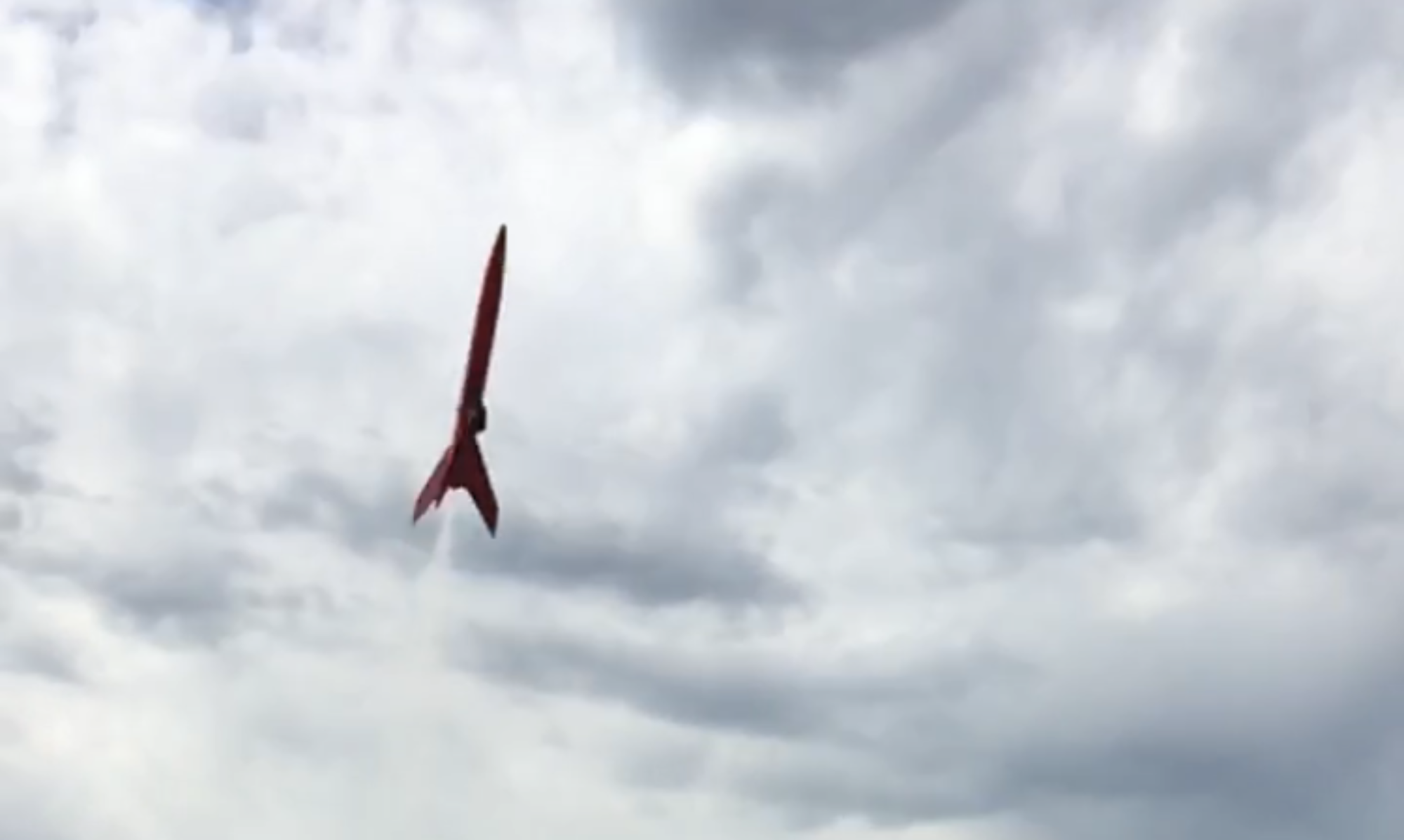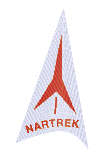This page will chronicle the progress through the National Association of Rocketry’s NARTREK Silver Achievement program.
In order to successfully complete this program, the following requirements must be met:
1. Make a successful model rocket flight, built from an existing kit or existing plans, of a rocket carrying a payload. The payload may be a Grade A Large hen’s egg, which must be flown and recovered without cracking the shell in any way. The payload may be a camera. If a camera is flown a picture taken from the inflight rocket must be included with the certification documentation. The payload may be a transmitter or computer. If an electronic device is flown a photo of the device must be included in the certification documentation. Detailed notes on the function of the electronic device and a summary of any data gathered during the flight must also be included. You may choose to fly a NAR standard competition payload (refer to the Pink Book for details). You may not fly live animals of any type. Take a photograph of your model and attach it to the certification sheet after completely filling out the rest of the form.
2. Make a successful flight of a model rocket, built from an existing kit or built from existing plans, propelled by three (3) or more simultaneously firing model rocket motors. This may be the same model used for the payload requirement. It is not necessary to fly any payload for this requirement, however. Take a photograph of your model and attach it to the certification sheet after completely filling out the rest of the form.
3. Make a successful thirty (30) second duration flight of a glide recovered model rocket that you have built from an existing kit or existing plans. Take a photograph of your model and attach it to the certification sheet after completely filling out the rest of the form.
4. Build and successfully fly a scale model from an existing model rocket kit, or construct a scale model from basic parts using scale data obtained from the sources outlined in the accompanying documents. With a second party, make an honest evaluation of your model using the form provided. Alternatively, enter your model in a NAR sanctioned Scale or Sport Scale competition, and have the contest scale judges fill out the certification form. Take a photograph of your model and attach it to the certification sheet after completely filling out the rest of the form. We have included judging sheets for both Scale and Sport Scale judging.
These individual sections were completed on the following dates, with the following rockets, motors, and, where applicable, times.
#1 – May 6, 2017 – Estes Super Alpha – Estes C6-5 – Carrying camera and altimeter
#2 – April 29, 2017 – Estes Baby Bertha – Estes A8-3
#3 – May 29, 2017 – Turnup Boost/Glider with Pop pod – Estes A8-3 – 40 – 40 seconds
#4 – May 21, 2017 – Estes Nike Smoke – Estes C6-5
The sections were not completed in order, and the following provides details for each section and its successful completion.
Make a successful model rocket flight of a rocket carrying a payload.
The currently out of production Estes Super Alpha rocket was chosen for this section. There were two payloads added to the exterior of the rocket to successfully complete this section. The first was a cheap 808 key chain video camera, and the second was a Jolly Logic Altimeter Three to record the flight data. The motor used was the Estes C6-5.
Both payloads were attached to the rocket using tape with a backup retention device for each device. The payloads were placed just forward of the Center of Gravity to keep the rocket stable in flight.
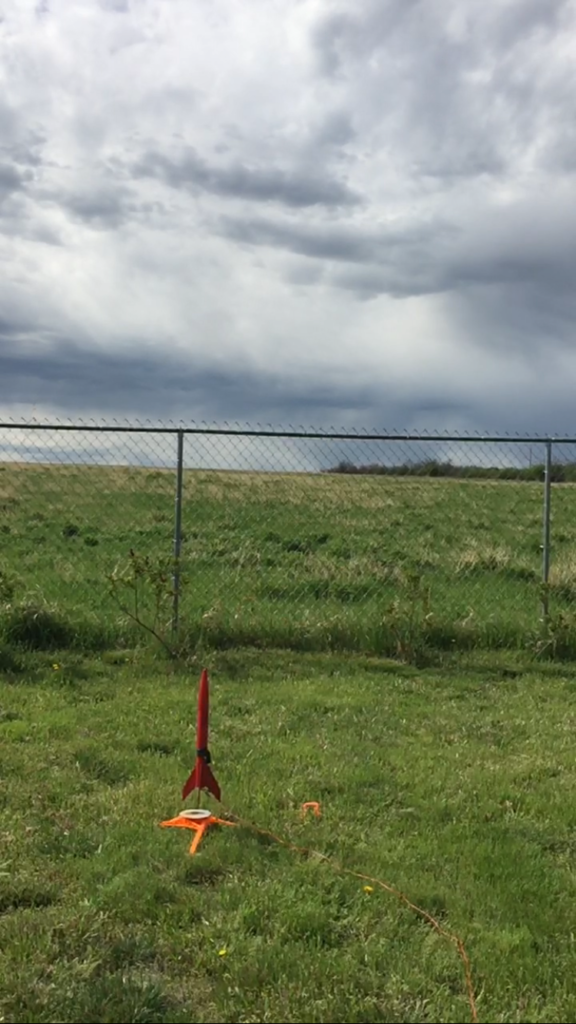
ATTEMPT #1 – SUCCESS
The rocket was prepped on May 6, 2017, and loaded with the C6-5 motor. The pre-flight check list included the additional steps of powering on the video camera and altimeter, activating the video recording, connecting to the altimeter using a smart phone via Bluetooth, and starting the altimeter’s recording.
The launch was without incident, and the rocket boosted straight off the pad.
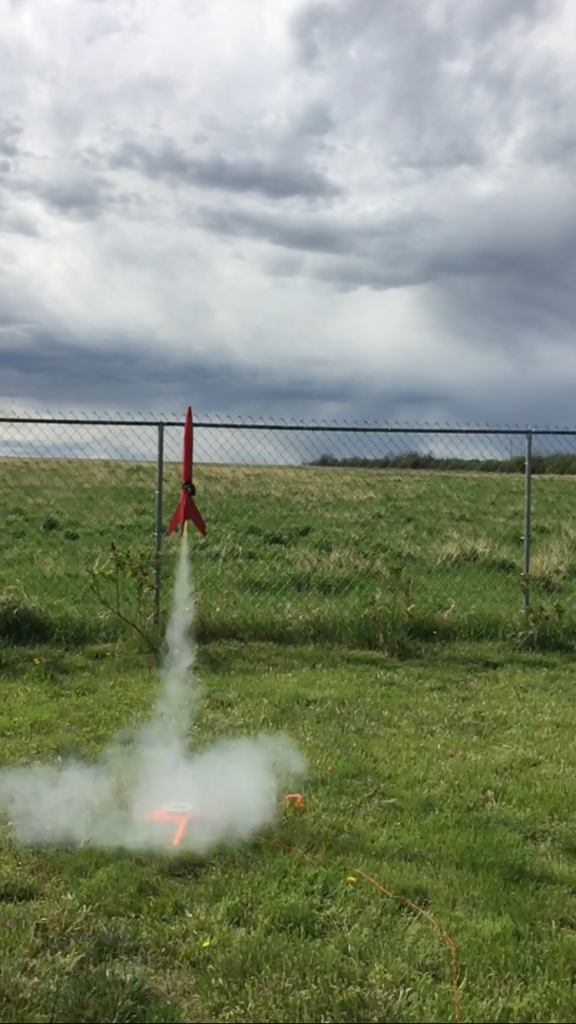
The ascent was straight up, and the rocket was successfully tracked to apogee.
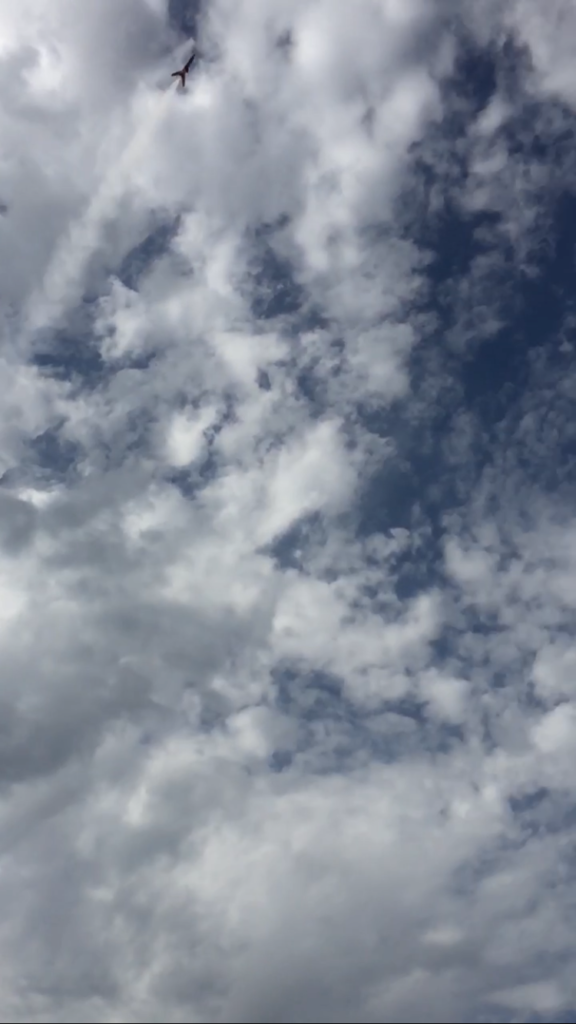
The parachute did not deploy at apogee, which appeared to significantly lower than a normal, non-payload, flight, but fired after the rocket had begun it’s decent. The ejection event was observed, and the parachute successfully deployed and fully inflated. The rocket was tracked through the decent to when it touched down.
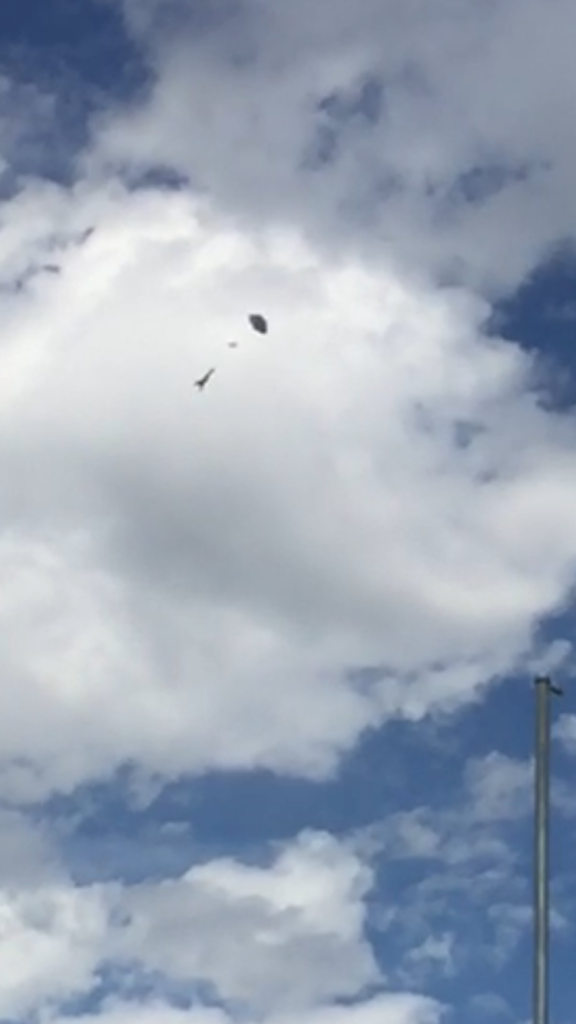
The rocket landed approximately thirty yards from the launch pad, very close to a building, and was recovered with no damage. Both the video camera and altimeter had made the flight with now damage, and both were still powered on when the rocket was recovered
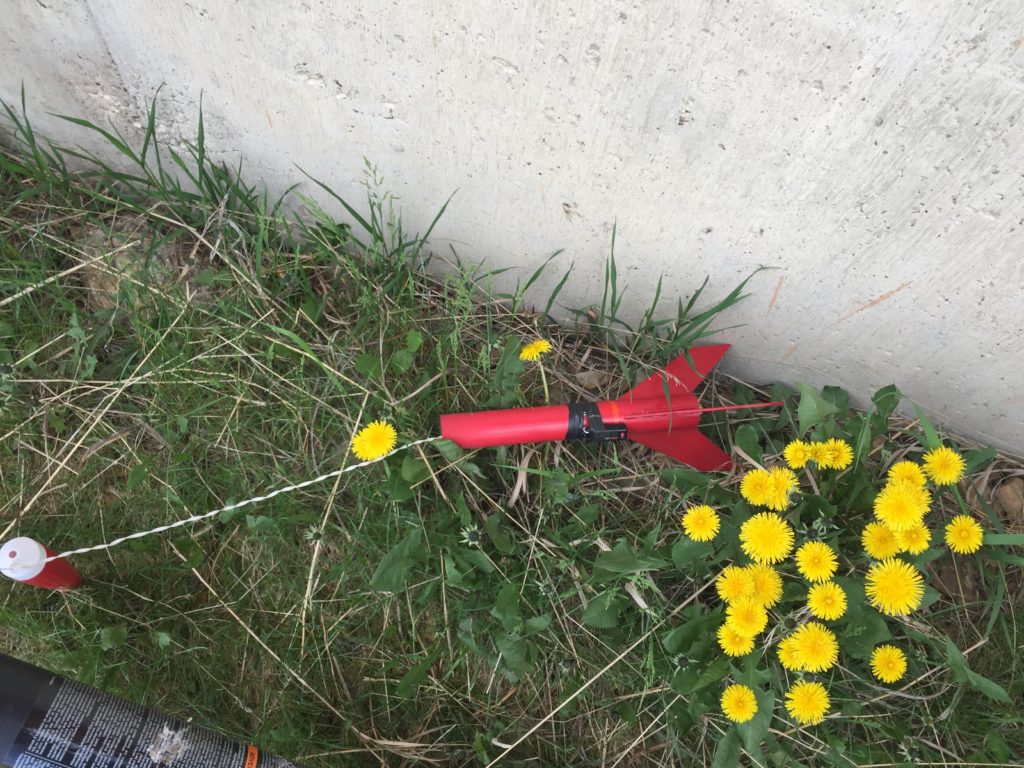
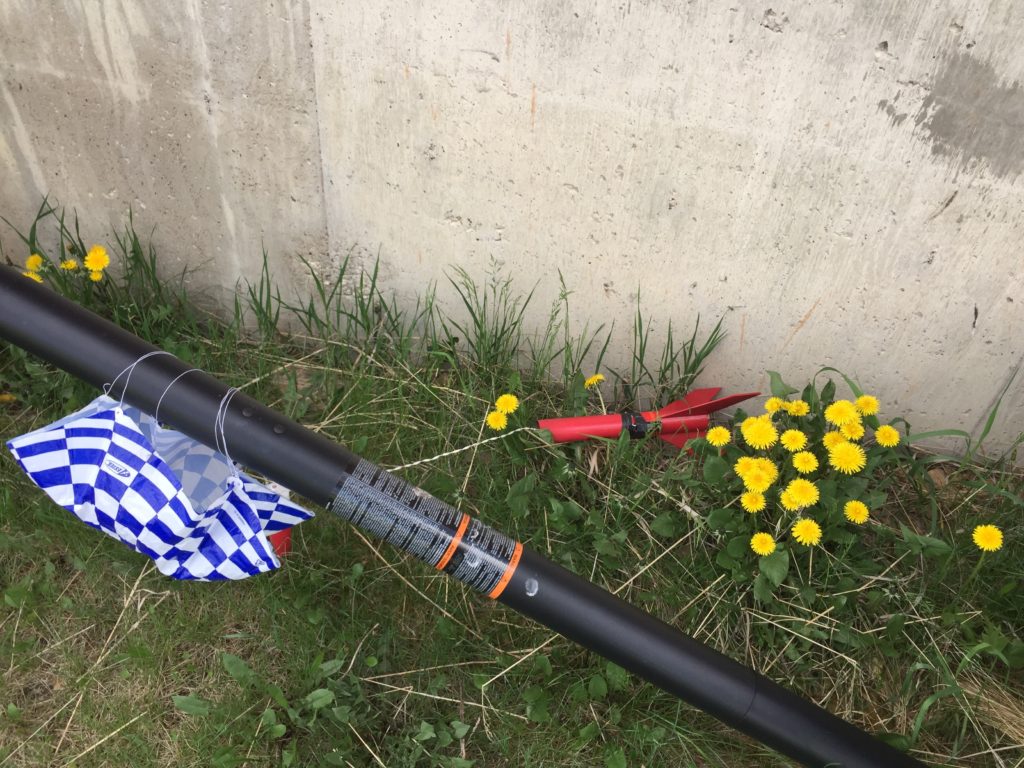
The video and altimeter data was downloaded from the respective devices, and both appeared to have functioned as expected.
The following still images were taken from the video.
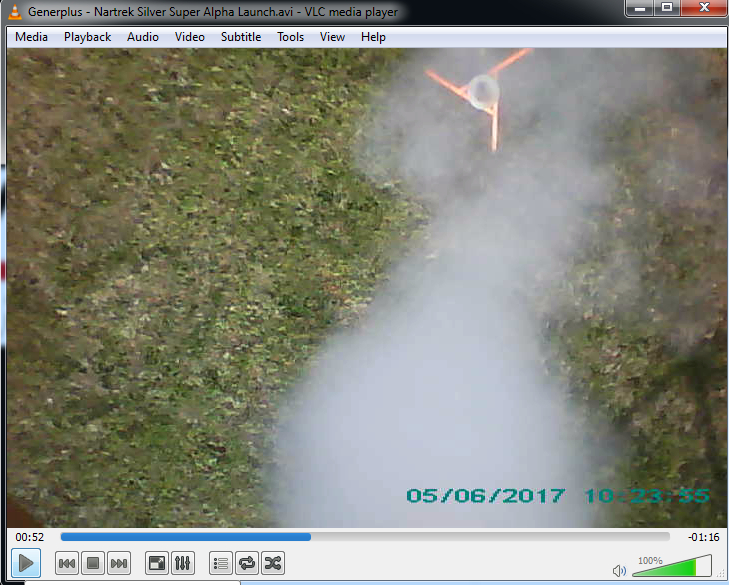
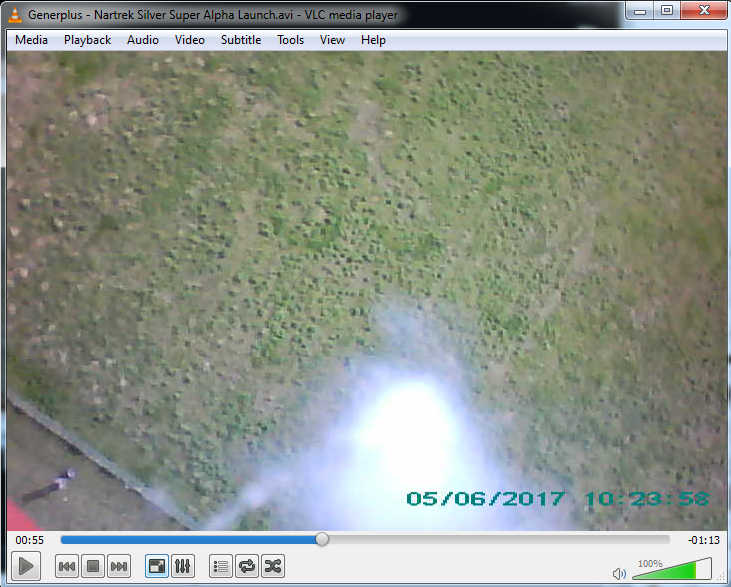
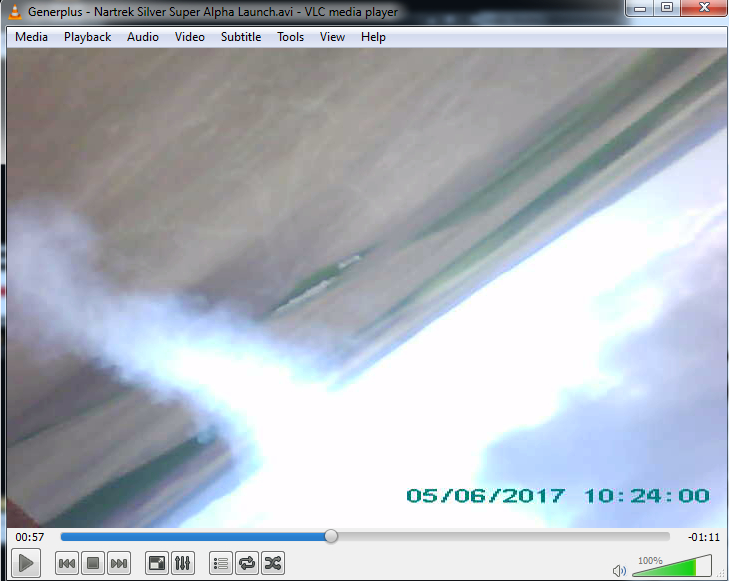
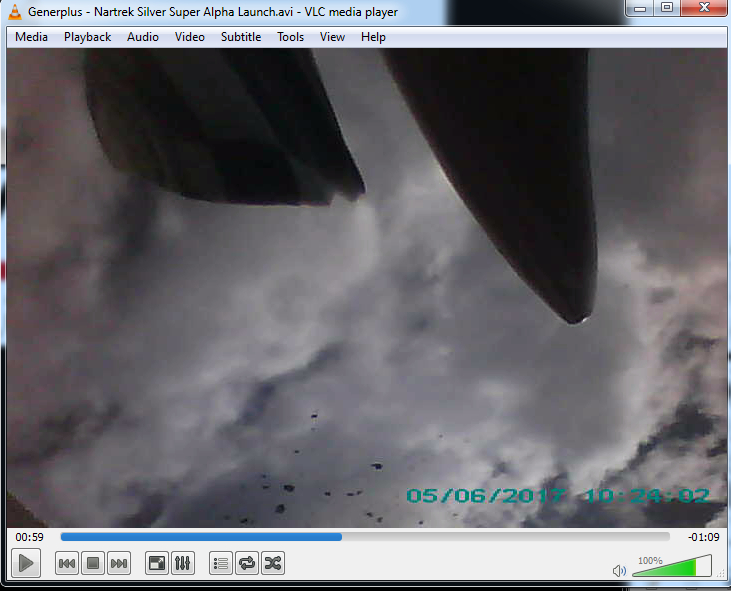
The altimeter data was downloaded into a graph and spread sheet, which are included here.
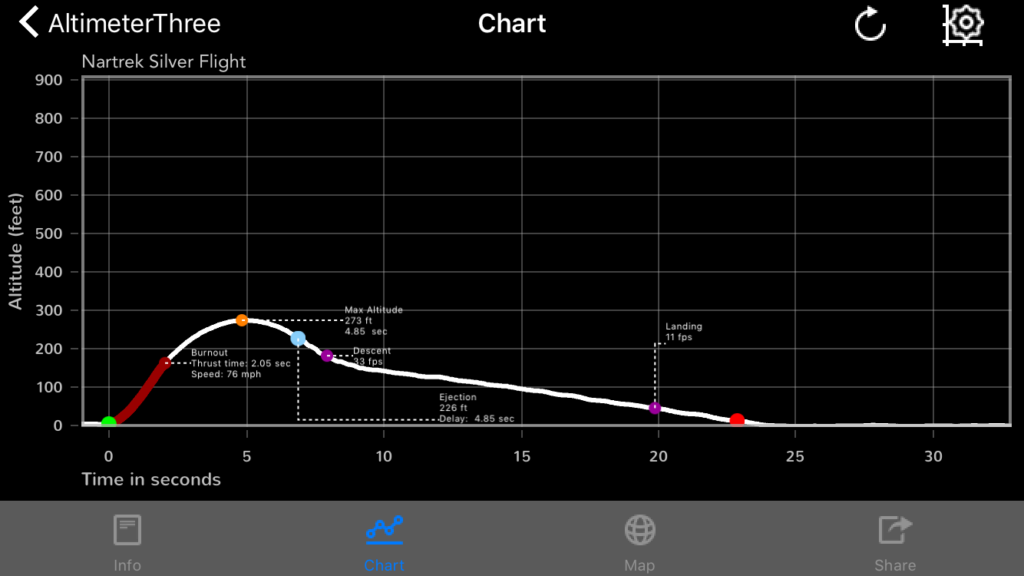
The max altitude achieved by the rocket was 273, which it reached in 4.85 seconds. The rocket’s maximum speed was 76 mph. As noted during the visual observation of the flight, there was a significant delay between apogee and the ejection event causing the rocket to reach a maximum descent rate of 33 fps before the parachute deployed and it slowed to 11 fps prior to landing.
Both the video and altimeter recorded the flight, and the data was extracted after the rocket was recovered, successfully completing this section of the Nartrek Silver Achievement on May 6, 2017.
Make a successful flight of a model rocket propelled by three (3) or more simultaneously firing model rocket motors.
The Estes Baby Bertha rocket was chosen for this section. The rocket was modified from the standard instructions to accommodate three engine mounts. The two extra motor mounts were built from an Estes Regular Engine Mount kit, and custom centering rings were cut from cardboard. The three motors were placed in a triangular pattern and the retaining hooks were placed to allow the motors to be removed, but not interfere with the other motors. The extra weight in the rear of the rocket moved the center of gravity, CG, to the rear of the center of pressure, CP, and nose weight was added to bring the CG back to the proper position. Almost 2 ounces of clay were secured in the plastic nose cone in order to accomplish the CG correction.
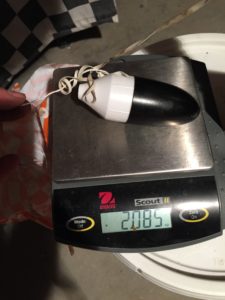
The standard Estes parachute was used for the main recovery device. The motors selected were three Estes A8-3.
ATTEMPT #1 – FAIL (One motor failed to ignite, ignition wire changed flight path)
The rocket was completed on April 29, 2017, and was prepped with the three Estes A8-3 motors as well as extra dog barf to protect the parachute from the three ejection charges. The three igniters were placed in a position that allowed for connection to three separate launch wires.
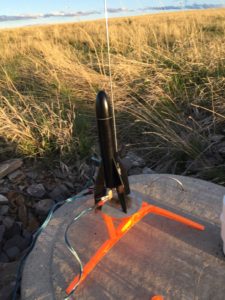
The original launch controller appeared to have a bad battery and a second launch pad and controller were then used.
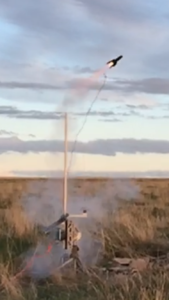
Upon launch, one motor failed to ignite and the wire connected to the motor’s igniter remained attached through the boost off the launch rod causing the rocket to angle over and then into the ground. The ejection charges of the two ignited motors fired, and the nose cone and parachute were ejected.
Post flight analysis showed that all three igniters had burned through, and it is likely that the failure to ignite the motor was caused by the igniter being pulled out of contact with the motor during the second launch rod re-loading procedure.
ATTEMPT #2 – SUCCESS
The rocket was reloaded with motors and then launched again on April 29, 2017. Extra care was taken to ensure than all the igniters were fully seated in the motors prior to launch.
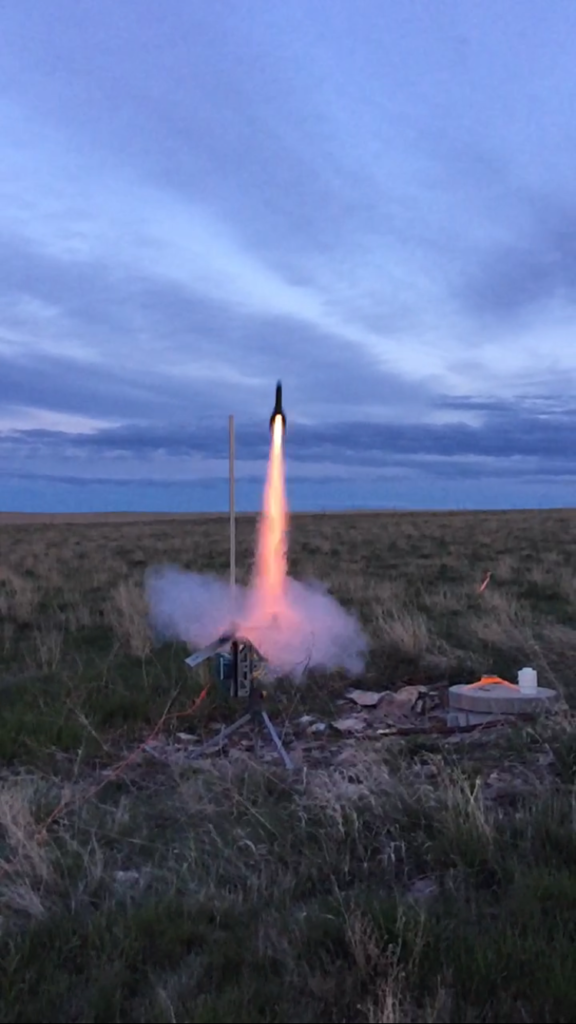
The launch was without incident, and the rocket boosted quickly off the pad.
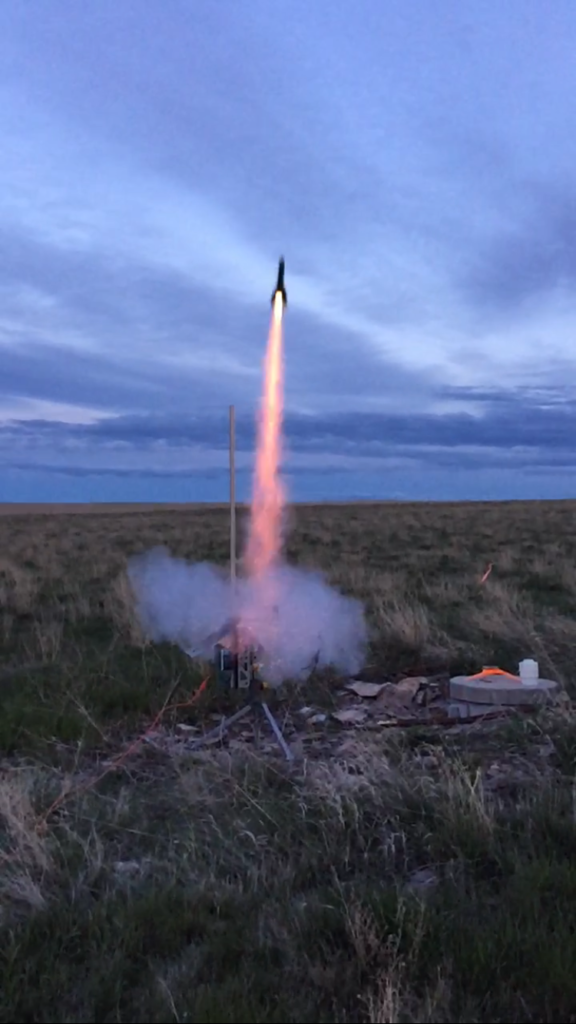
The ascent was straight up, and the rocket was successfully tracked to apogee. An ejection event was observed, and the parachute successfully deployed but did not inflate fully. The rocket was tracked through the decent to when it touched down. The decent was faster than expected due to the failure of the parachute to fully inflate, however the large fins created a “flutter recovery” effect. Post flight analysis showed that the parachute had been melted in two locations causing the chute to fuse and fail to fully open.
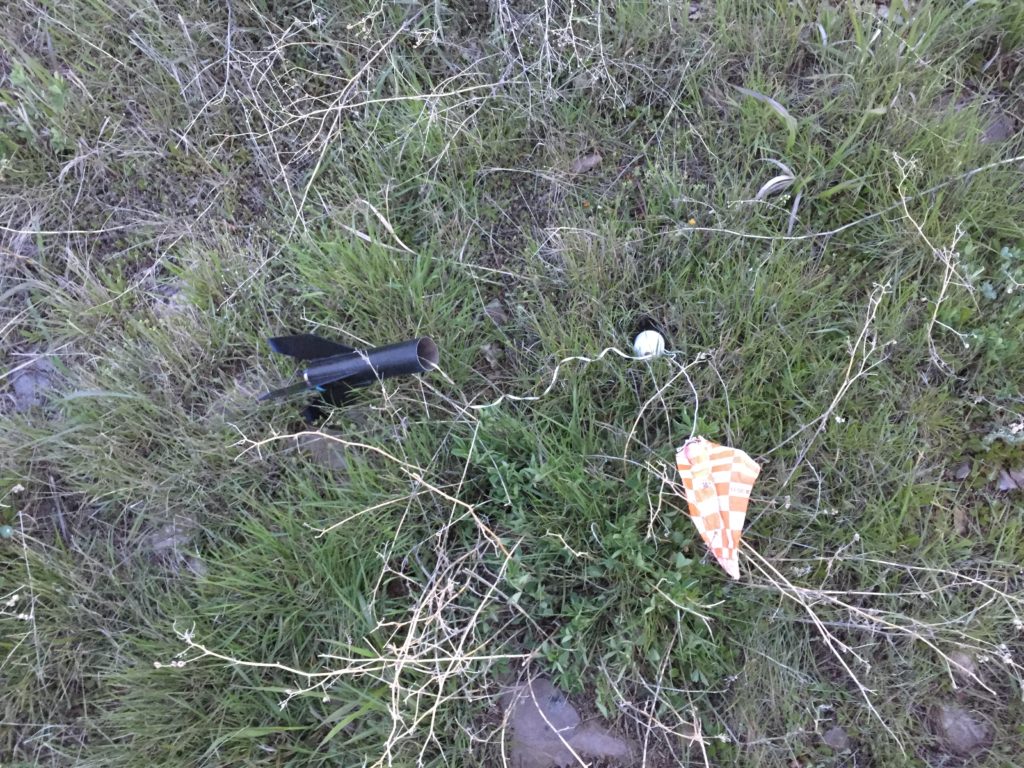
The rocket landed approximately three yards from the launch pad, and was recovered with no damage.
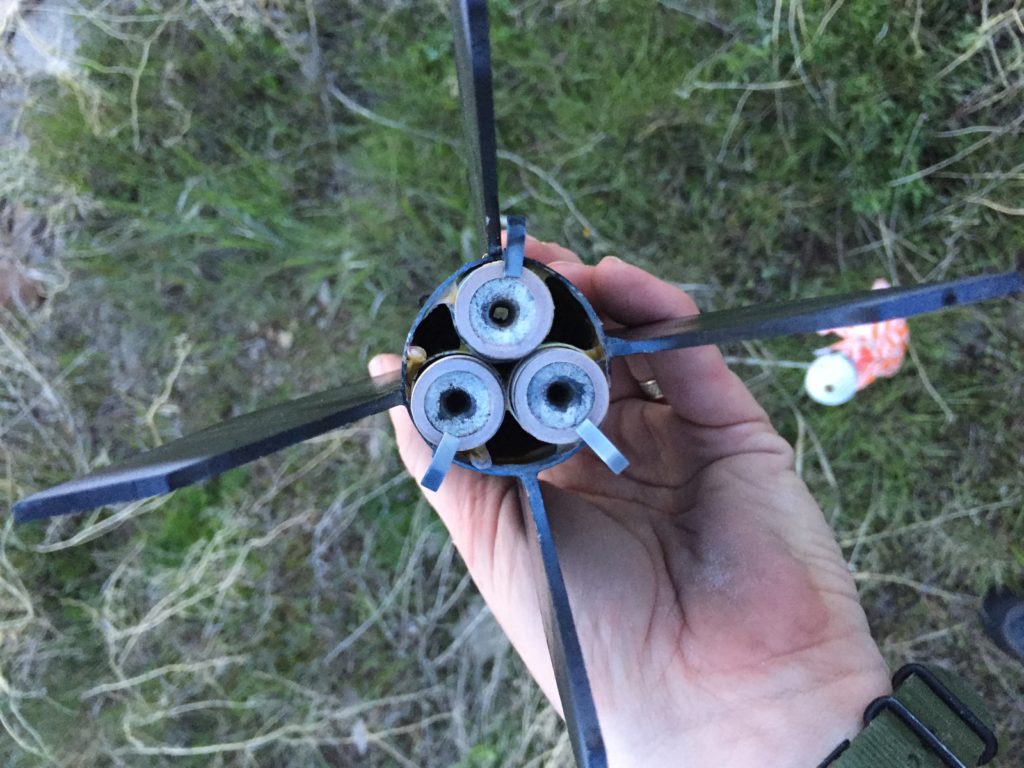
All three motors had fired this time, successfully completing this section of the Nartrek Silver Achievement on April 29, 2017.
Make a successful thirty (30) second duration flight of a glide recovered model rocket that you have built from an existing kit or existing plans.
The Estes Astron Skydart II rocket was originally chosen for this section. The rocket was completed per the Estes instructions, but was left primed but unpainted in order to save weight. After the rocket was completed, numerous hand-thrown glide tests were conducted in an effort to get the optimal glide and ensure that the glider would circle during decent. The Estes C6-5 motor was used, along with the standard Estes parachute. We later realized that the requirements state that it must use a B or smaller motor and the http://www.nar.org/wp-content/uploads/2014/05/Status4-1-2A-A-RG-Beach.pdf was built and flown with an Estes 1/2A3-4 motor.
ATTEMPT #1 – FAIL (Glider touched down in 22.1 second)
The rocket was completed on May 7, 2017, and despite less than ideal weather conditions (6-10 mph winds, heavy rain clouds), an attempt was made.
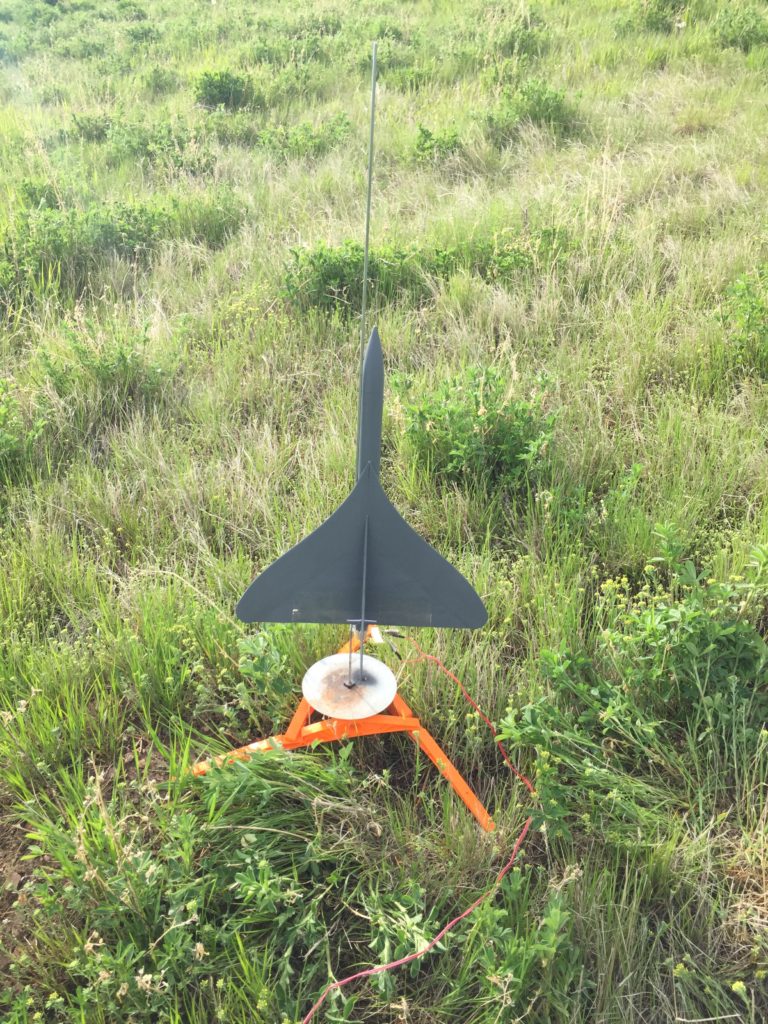
I was assisted with the launch, and the time was witnessed by Iain.
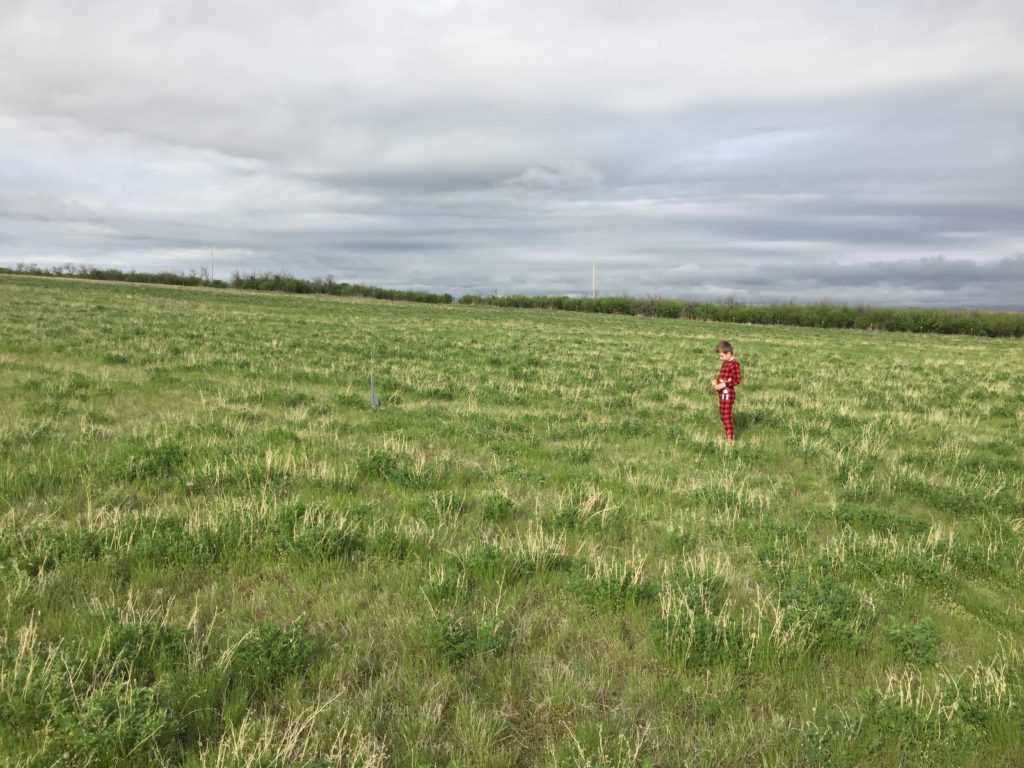
The launch was without incident, and the rocket boosted quickly off the pad.
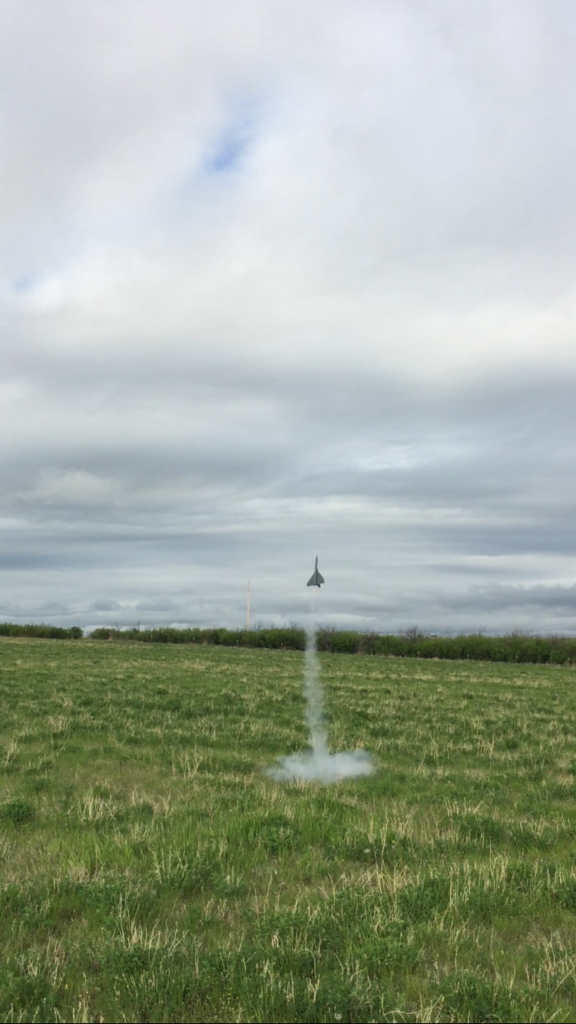
The rocket began to weathercock shortly after clearing the launch rod, causing the rocket to reach apogee at a much lower elevation than anticipated. The rocket was successfully tracked to apogee. An ejection event was observed, and the parachute successfully deployed. The glider portion of the rocket transitioned to the gliding flight successfully, and the flight path was appropriately curved, but the decent was too steep to achieve the required duration, and the rocket touched down at 22.1 seconds.
Both the rocket and engine tube with parachute were recovered without damage. The rocket was approximately 100 yards from the launch pad, and the engine tube was approximately 150 yards away.
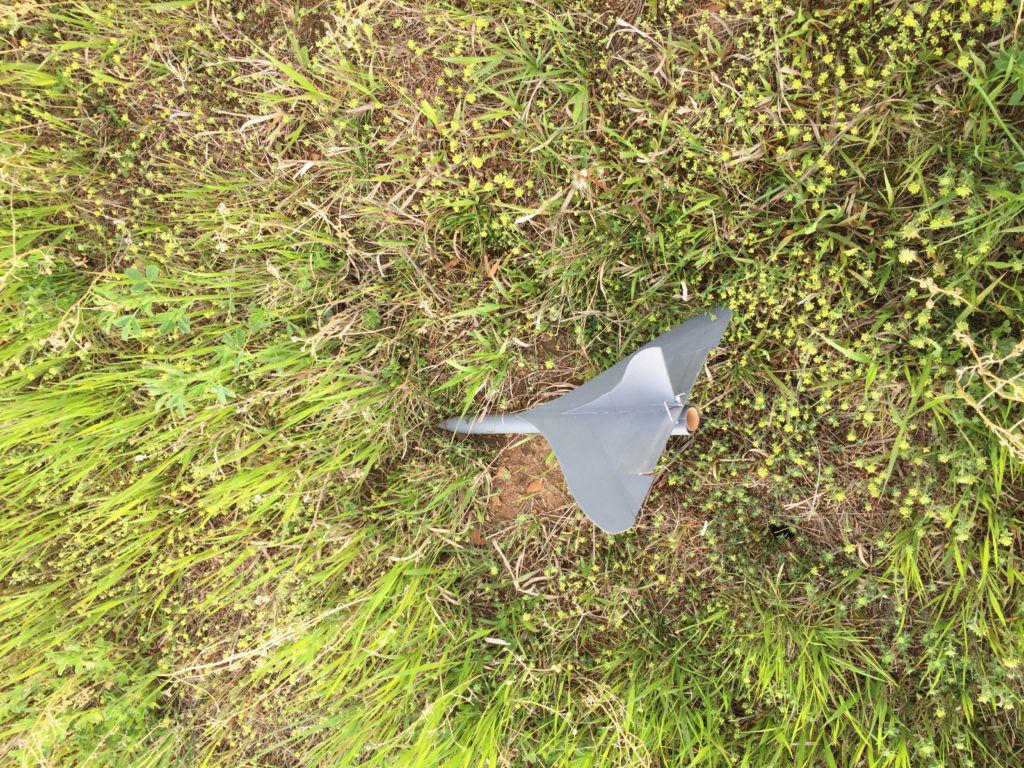
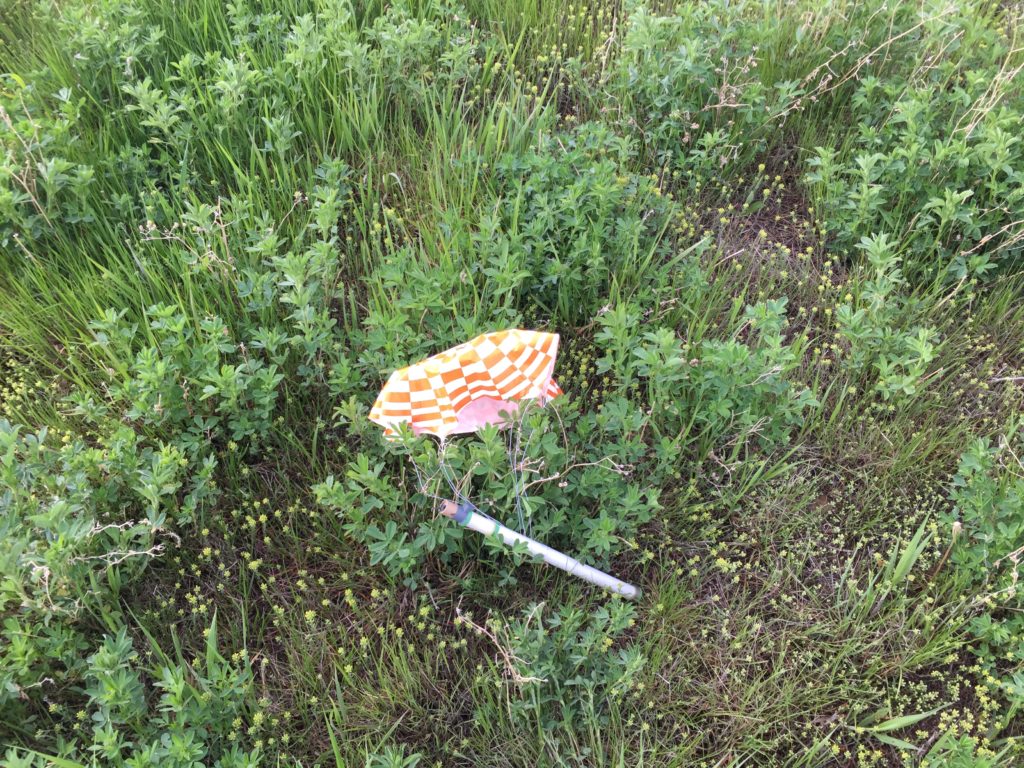
ATTEMPT #2 – Fail (made the time but later learned the launch required a B or smaller motor)
The rocket was reloaded with another motor C6-5 motor and then launched again on May 7, 2017. The screw that controls the elevator pitch was adjusted to provide more climb prior to launch.
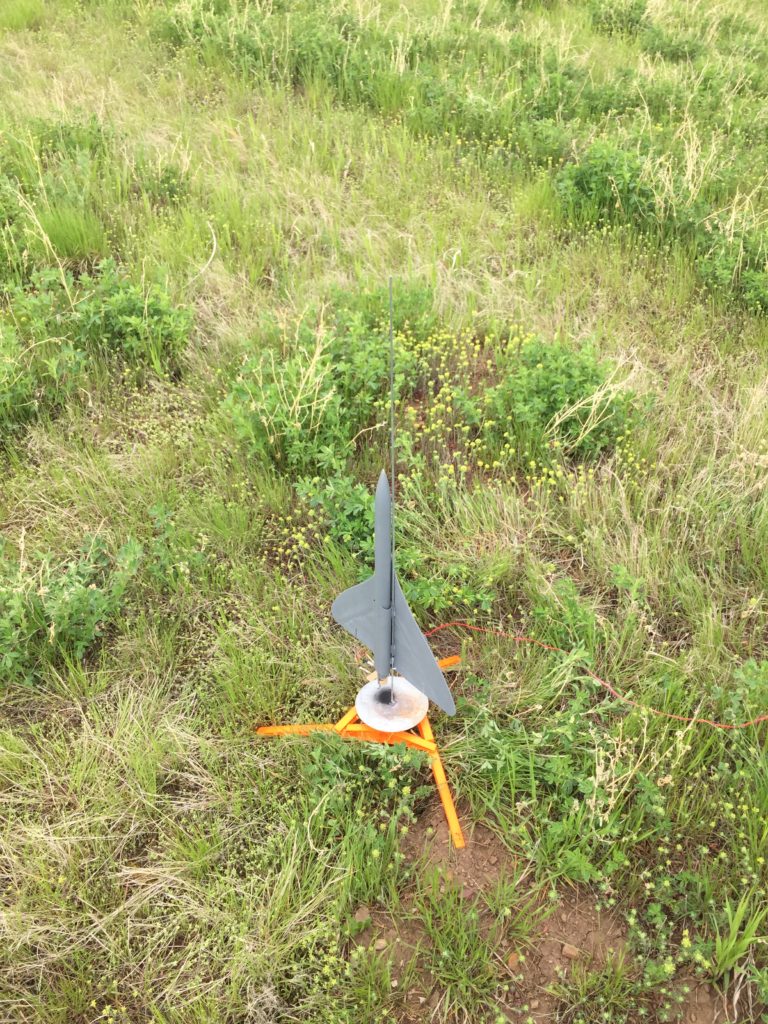
The launch was without incident, and the rocket boosted quickly off the pad.
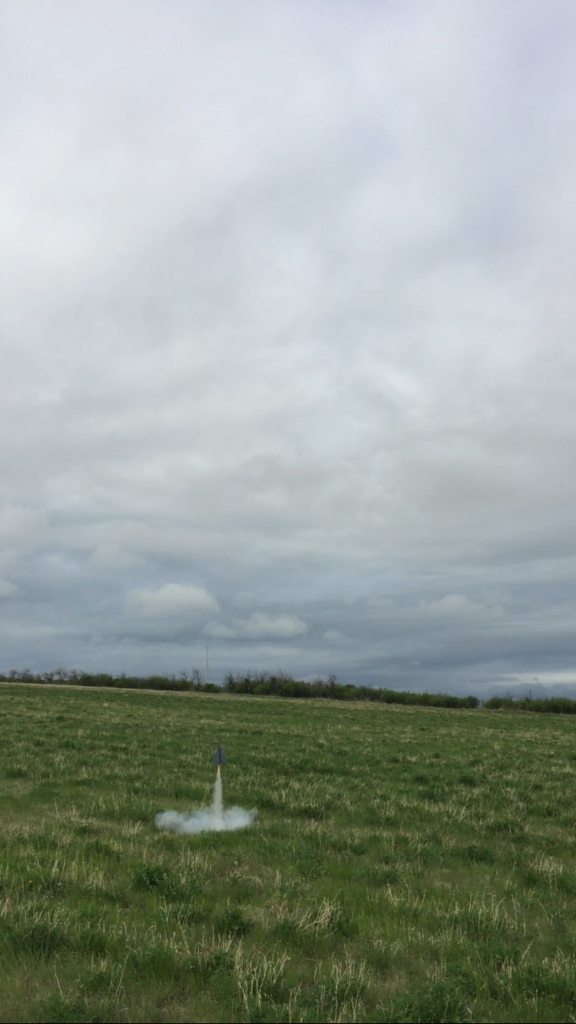
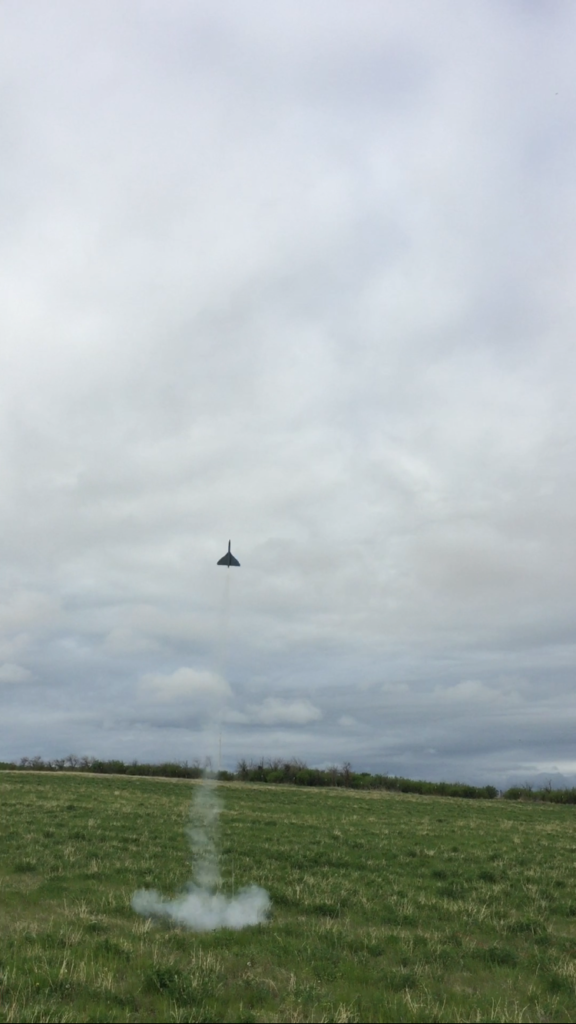
The ascent was straight up and the rocket was successfully tracked to apogee. An ejection event was observed, and the parachute successfully deployed. The glider portion of the rocket transitioned to the gliding flight successfully, and the flight path was appropriately curved with a slower decent compared to the first attempt. The rocket was lost to sight behind a hill, but the moment it was out of sight was counted at the touch down. The time was 30.42 seconds.
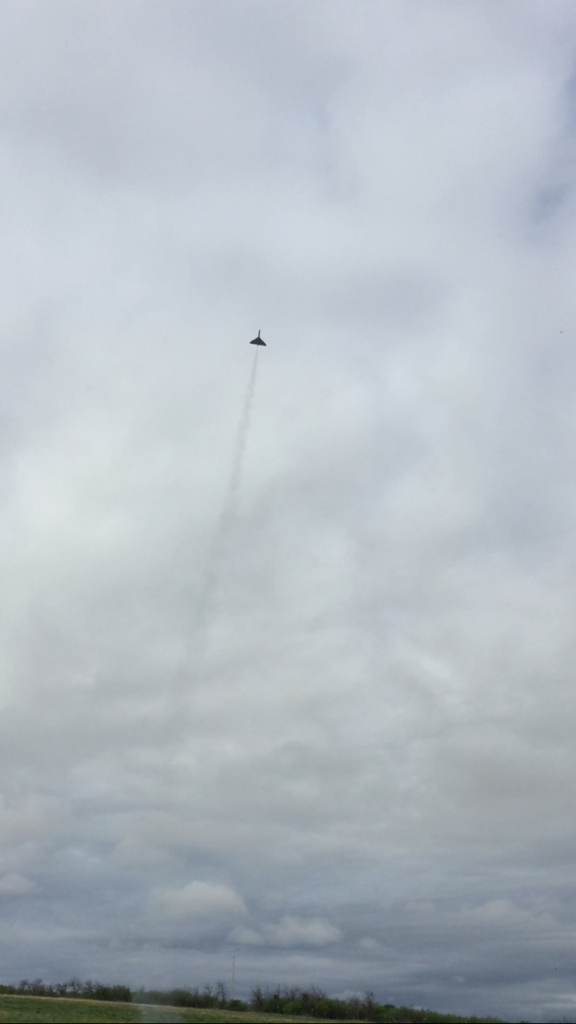
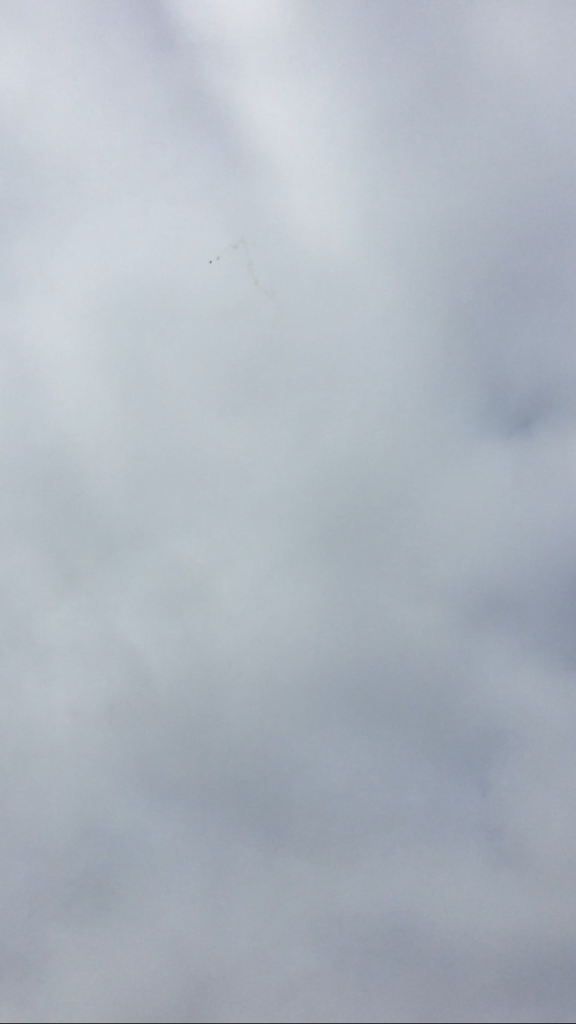
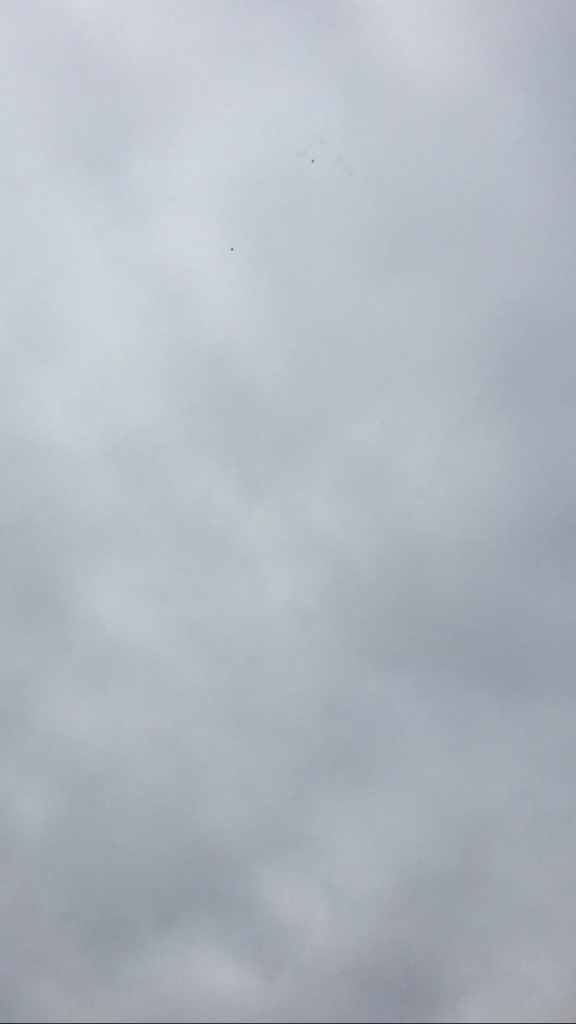
The rocket landed approximately two hundred yards from the launch pad, the engine tube with parachute approximately 275 yards, and both were recovered with no damage.
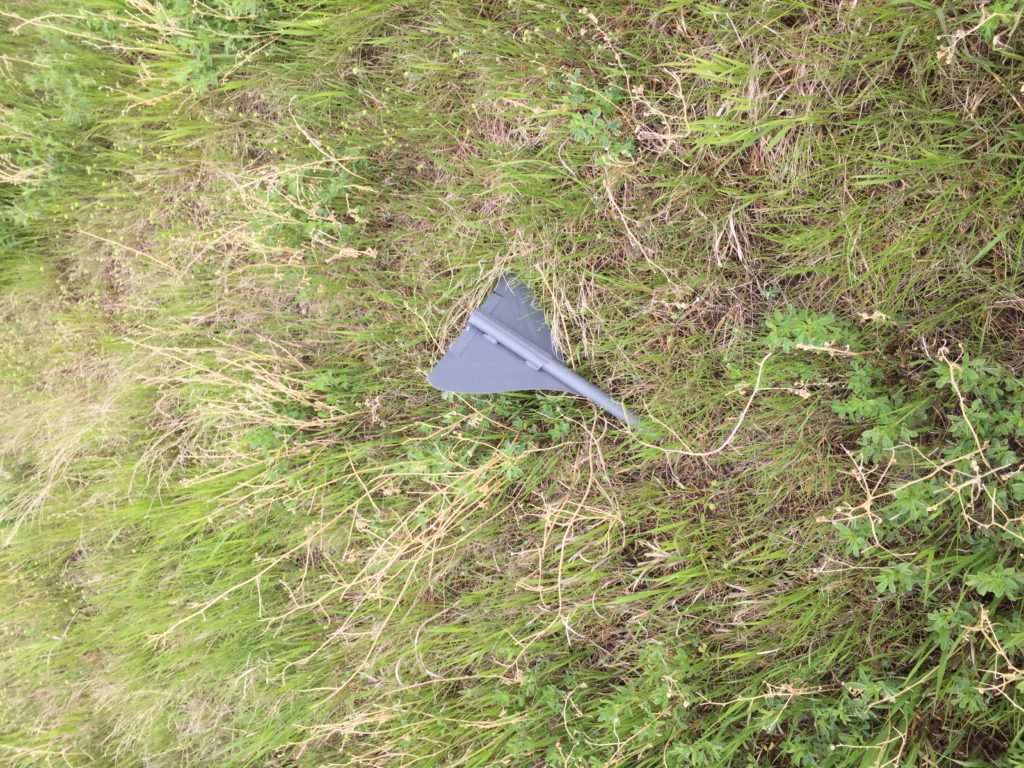
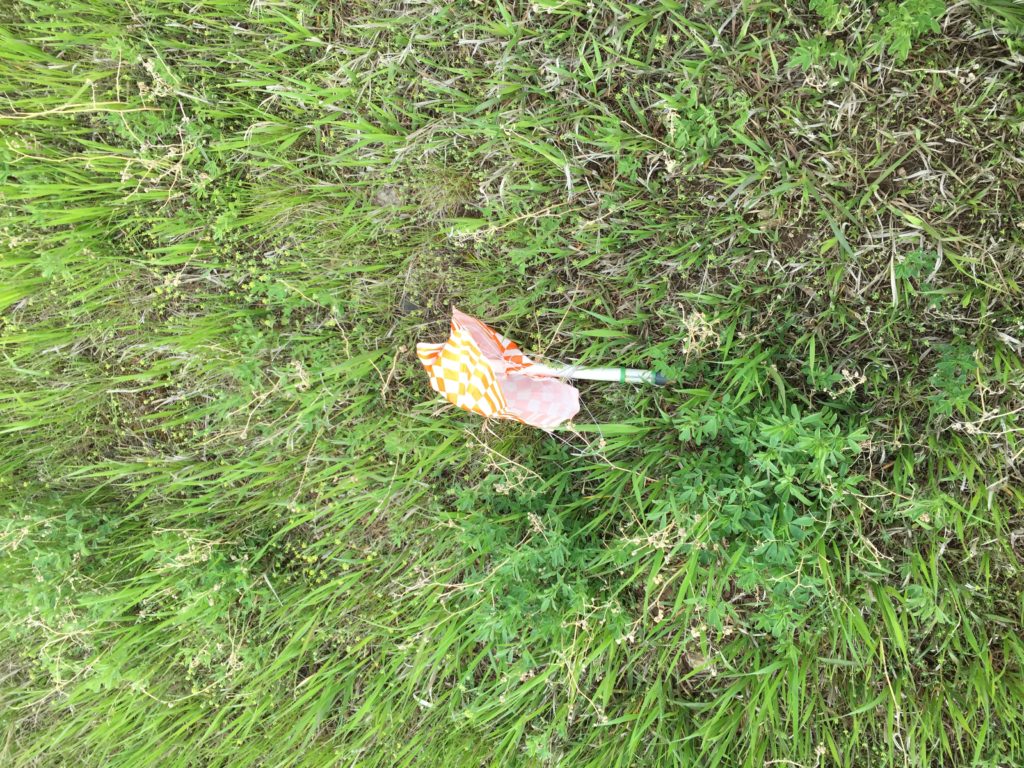
The rocket glider landed 30.42 seconds after liftoff, successfully completing the time requirement of this section of the Nartrek Silver Achievement on May 7, 2017, 2017. While completing the paper work for submission, it was noted that a B or smaller motor was required for this section. This was not noted on the requirement form, but was stated in one of the supporting documents.
ATTEMPT #3 & 4 – Fail (unable to reach required glide duration)
On May 23, 2017, the rocket was loaded with a Estes A8-3 motor and launched again. Although the rocket boosted of the pad normally, it reached apogee very quickly and was almost to the ground before the ejection charge fired. Although the model landed without damage, it was unable to transition into a stable glide mode and the total time of flight was only 4 seconds.
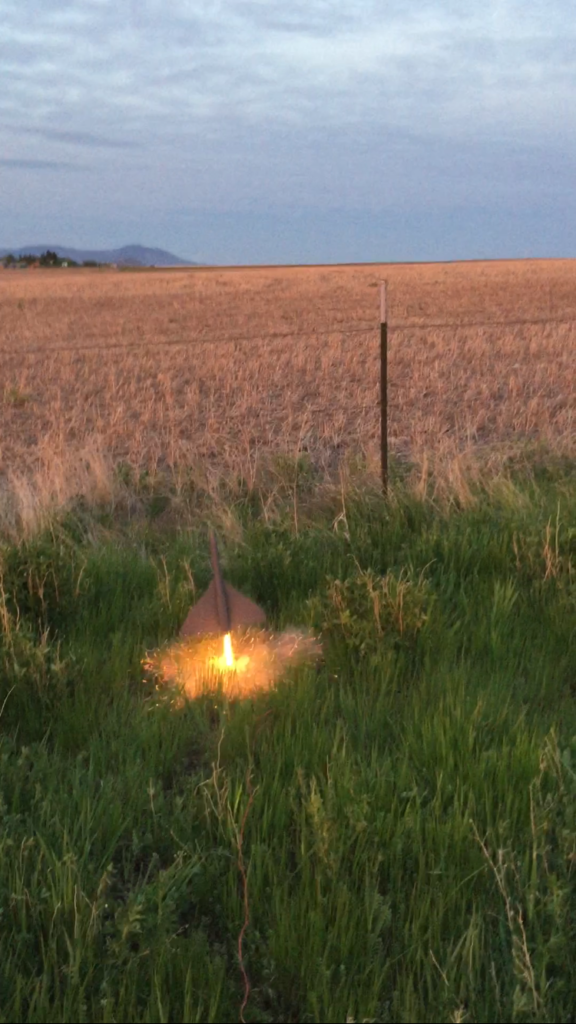
A second launch was immediately conducted, but the same results occurred with a 5 second flight.
Design Change #1
The requirement to use a B or smaller motor to achieve this section, and the less than stellar performance of the Astron Skydart II on a C6-5 indicated that that model would be less than optimal at achieving this goal. The Nartrek Silver packet contains a number of plans to build various glider models, and the following section will detail the various models built and flown.
ATTEMPT #5 – #9 – Fail (unable to reach required glide duration)
The first model built was the Status-4 rocket glider, designed by Tom Beach, with the plans included in the NARTREK packet for this level. The design involved a wing that was held to the rear of the model during the boost phase with a string that burned through by the ejection charge allowing the wing to spring forward (powered by a rubber band) transitioning to a glide position. The motor mount was built from an old nose cone and 13mm body tube with a hole bored just below the nose cone shoulder to allow the ejection gases to escape and to provide a place for the release thread to run.
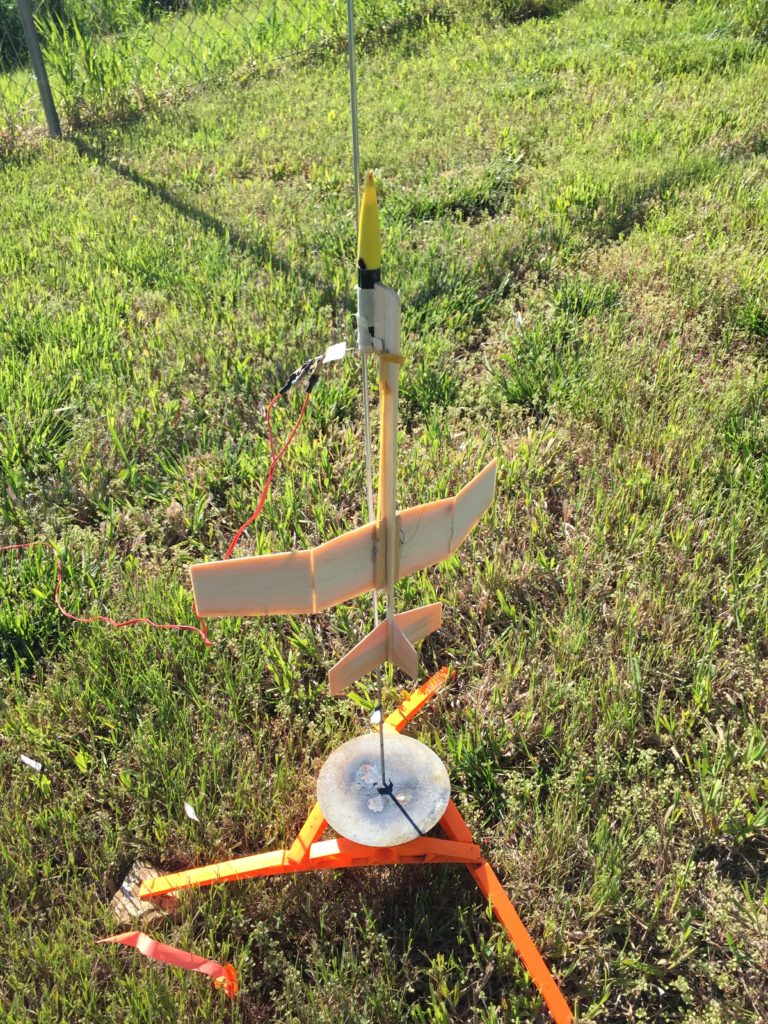
On the morning of May 26, 2017, the rocket was launched five times using an Estes 1/2A3-4T motor.
The first two launches weather cocked hard over at launch, and were unable to transition into a stable glide mode after the ejection charge fired. They landed in 5 seconds and 4 seconds respectively. Post flight analysis showed that the wing transition mechanism was working correctly, it was just too close to the ground before the string released the wing.
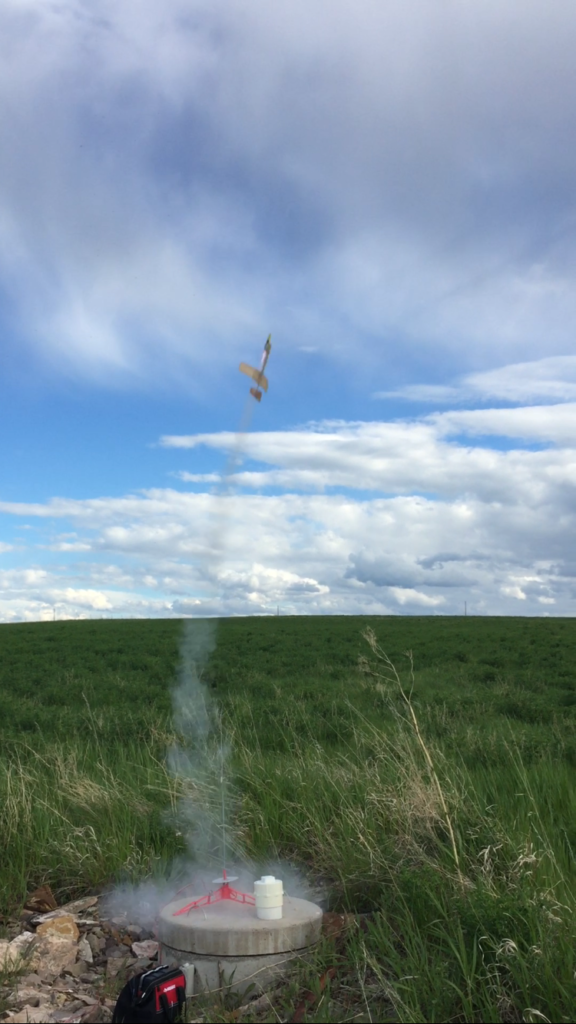 Status – 4 rocket glider
Status – 4 rocket glider
The launch pad was adjusted and the rocket launched again. The boost was more straight up, but the rocket reached apogee and was well into the descent before the ejection charge deployed. The wing transitioned successfully and the rocket transitioned into a stable glide, landing 14 seconds after launch.
The rocket was launched two more times using the same motor. Both flights ended after 6 seconds with the rocket too close to the ground while transitioning to glide mode to achieve any duration.
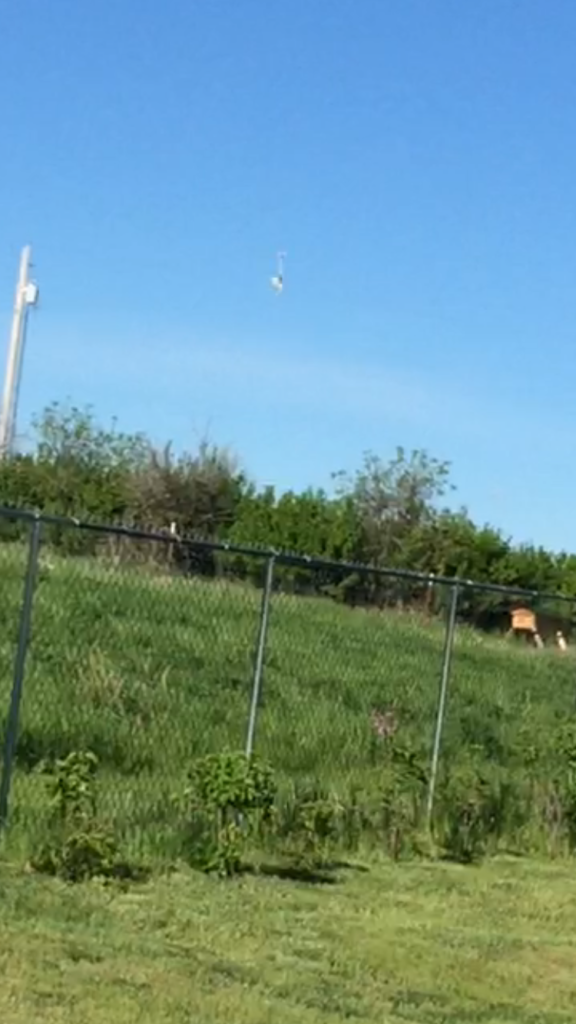
The last flight landed on a rocky patch of ground breaking the model’s wings and main body into multiple, large pieces, but leaving the wing transition mechanism unhurt.
ATTEMPT #10 – #13 – Fail (unable to reach required glide duration)
The rocket was rebuilt and Estes 1/2A3-3T motors were obtained to allow the ejection charge to fire higher in the flight. The second string of launches were conducted during the evening of May 26, 2017.
The first launch saw the rocket slip down over the tape flag used to support the motor mount on the launch rod, and the rocket was stuck on the rod while the motor burned.
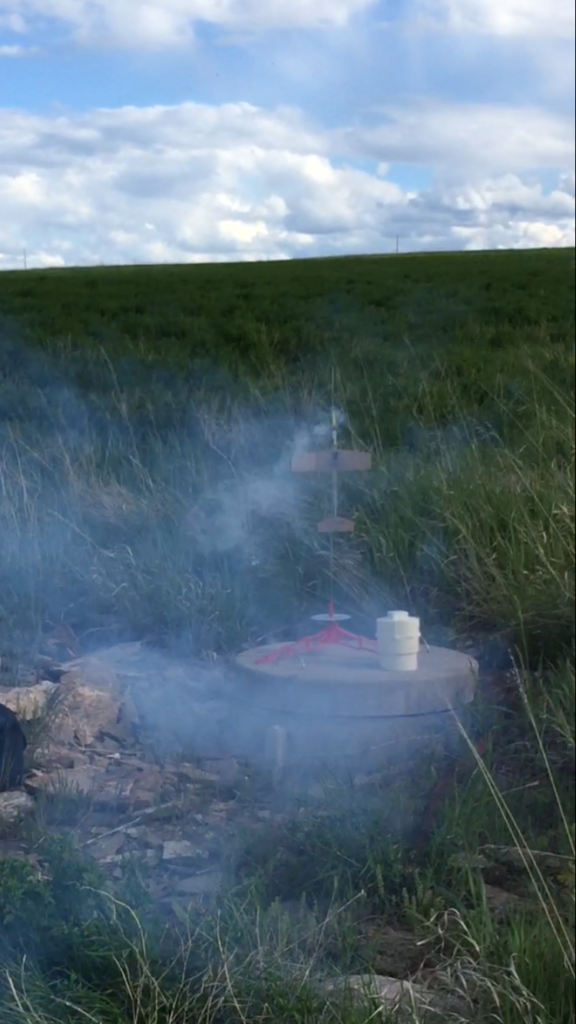
The rocket was undamaged and immediately reloaded with the same motor. The second launch saw a good boost, but the ejection charge still was too delayed to allow the rocket to transition into a stable glide before landing after 4 seconds.
Two additional launches were conducted with the Estes 1/2A3-4T motor with 6 and 4 second durations. The final launch ended with the rocket impacting a concrete pad, splintering the model and destroying the wing transition mechanism.
Design Change #2
The inability to transition to glide mode high enough from the ground using the available motors required a rethink on the process, and a second model, the Turnip boost glider, designed by P. Playmaker, and included in the NARTEK Silver packet and available on the NAR website was built. The plans did not include a pop pod design, which was required to launch the glider, and a similar design to that used on the Status-4 was used.
ATTEMPT #14 – #18 – Fail (unable to reach required glide duration using B or smaller motor)
The rocket was completed on May 27, 2017, and launched with aEstes 1/2A3-4T motor.
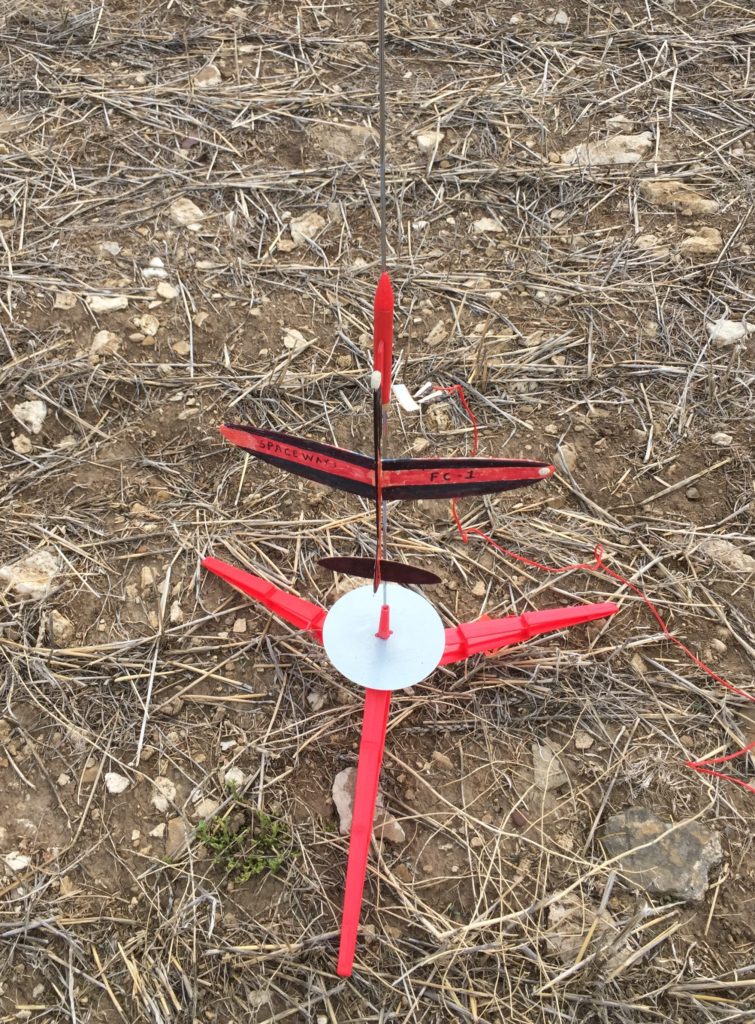
The boost phase was without incident, but the pop pod did not separate from the glider body at apogee, and the rocket tumble recovered, landing 3 seconds after launch.
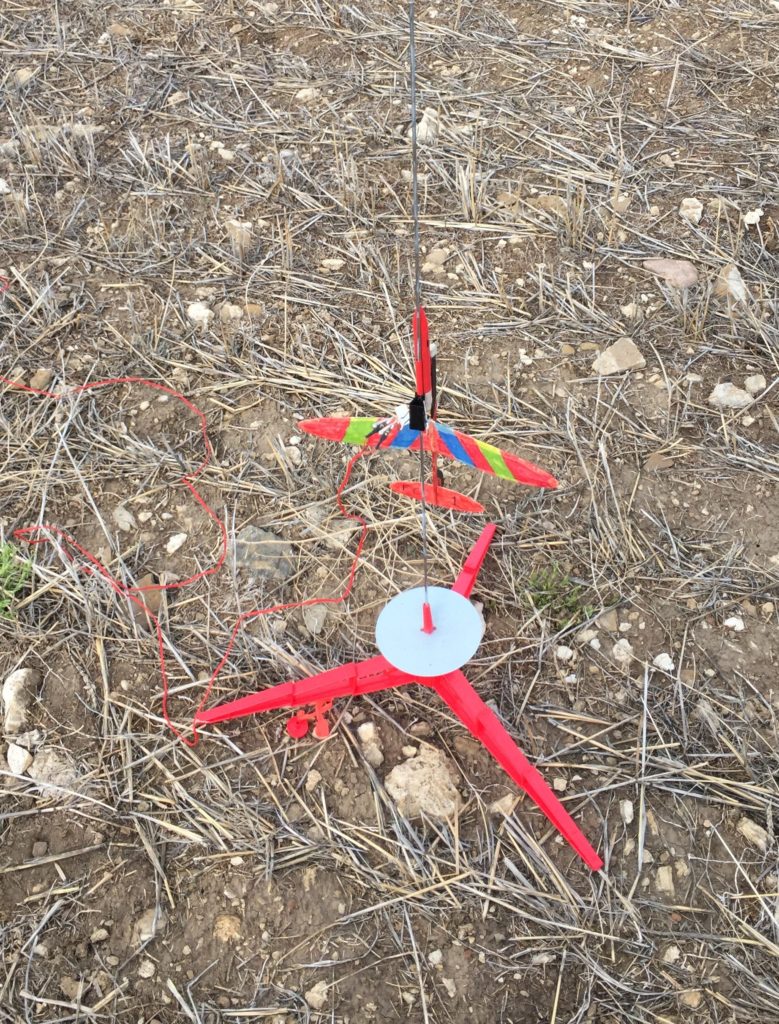
Three additional launches were conducted with the same motor, but the pop pod hook was modified each time to attempt to allow it to separate after the boost phase. The times were 3, 4, and 4 seconds respectively, and all flights failed to have the pop pod separate from the glider body before impact.
The rocket was then loaded with an Estes 1/2A3-3T motor and launched. The same issue occurred, with a landing time of only 2 seconds after launch.
Design Change #3
The inability to eject the pop pod after boost would not allow the glider body to make a glide recovery. It was obvious that something was not working correctly with the pop pod design, but a lack of experience was preventing its identification (note, it was later determined that the fix nose cone would not allow for the ejection event to trigger the pod ejection). It was then decided to utilize a Estes Payloader II rocket as the boost vehicle carrying the Turnip glider body. Small spars were added to the Payloader’s body tube and fins which allowed the Turnup to remain stationary during boost. A piece of string was secured around the nose of the glider and held in place by the nose cone of the rocket. When the nose cone was ejected, the string would release the glider body and it would separate from the rocket.
ATTEMPT #19 – #20 – Fail (unable to reach required glide duration using B or smaller motor)
The rocket redesign was completed on May 27, 2017, and launched with a Estes A8-3 motor.
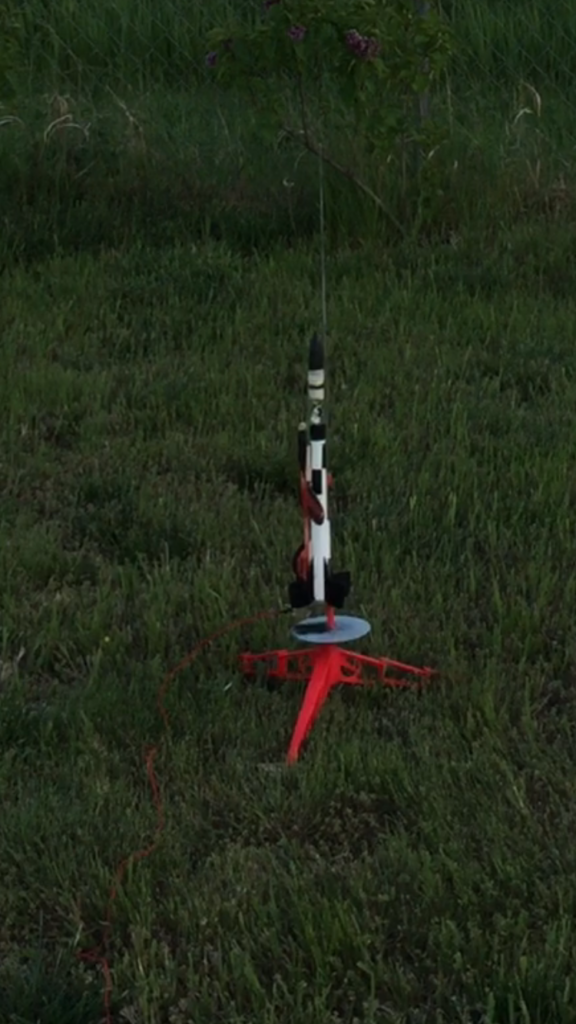
The rocket appeared to be marginally unstable, and the boost stage did not reach a high altitude before apogee. When the ejection charge fired, the rocket was only about 30 feet from the ground, but the glider was released and began a glide descent before touching down 3 seconds after launch.
The rocket and glider were re-prepped for launch with an Estes C6-5 motor to determine if the glider would actually function as a glider during descent. Additional weight was added to the payload section in the form of a screw and modeling clay.
At launch, the rocket began to weather cock immediately after clearing the launch rod, and continued to lay over while gaining elevation. When the ejection charge fired, the glider separated from the rocket and began a slow, circular descent.
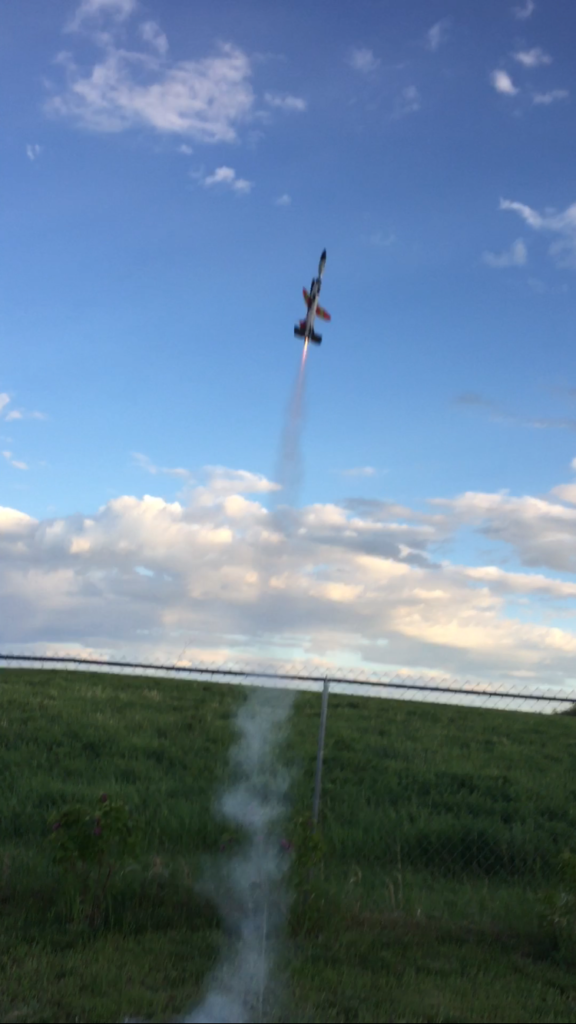
After 2 minutes and 30 seconds, the glider was lost to sight (flew in front of the sun), and was unable to be located for recovery. The rocket body was successfully recovered approximately 300 yards from the launch pad.
Despite the setback in being unable to locate the glider body, the duration of flight before it was lost (and it was still well above ground level when it was lost) verified that the design worked and a new glider body was built.
ATTEMPT #21 – #23 – Fail (unable to reach required glide duration using B or smaller motor)
On May 28, 2017, the new glider body was attached to the Estes Payloader II and the rocket was loaded with an Estes A8-3 motor. The rocket appeared to be too heavy for the motor and ejection charge fired just feet above the ground. The glider was released, and did transition into glide mode, but landed 4 seconds after launch.
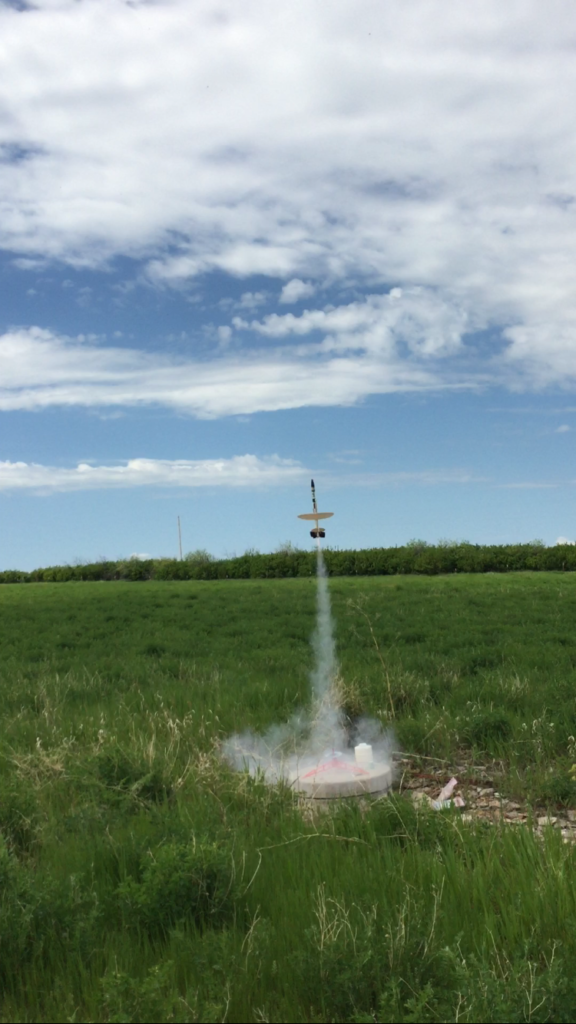
The rocket was re-prepped, with the same motor, and after removing the majority of the clay weight, it was launched again. The rocket again weather cocked after leaving the launch rod, but the angle was much smaller and the rocket continued to gain altitude throughout the boost stage. The glider was released with the ejection charge and began a gliding descent, landing 13 seconds after launch.
The rocket was again re-prepped, but with a C6-5 motor, with the thought to determine the average of the last two flights so a decision could be made about attempting to obtain a B motor.
The rocket weather cocked at launch, but again gained significant elevation before the ejection charge fired, releasing the glider. The glider began a slow, circular descent and landed 42 seconds after launch.
Design Change #4
Although it appeared that they Payloader boosted Turnip could possibly be used to reach the required duration, the numbers were right on the edge, and it was decided to revisit the Pop Pod design originally called for on the Turnup model. After consulting the Handbook of Model Rocketry, by G. Harry Stine and Bill Stine, another pop pod was constructed based on the Midnight Express model rocket used in the Nartrek Bronze duration requirements. The fin can of the rocket was removed, and the body was secured to a hook mechanism sitting 1/2″ above the glider body. It appeared that the pop pod design required a forward moving mass at motor burn out to cause the rearward movement required to detach the pod hook from the glider body. Once this, in hindsight obvious, piece of information was understood, the rest of the build was quickly accomplished.
ATTEMPT #24 – Success (40 second flight time)
The Turnup A Boost Glider along with the new pop pod was used for the glider along with an Estes A8-3 motor.
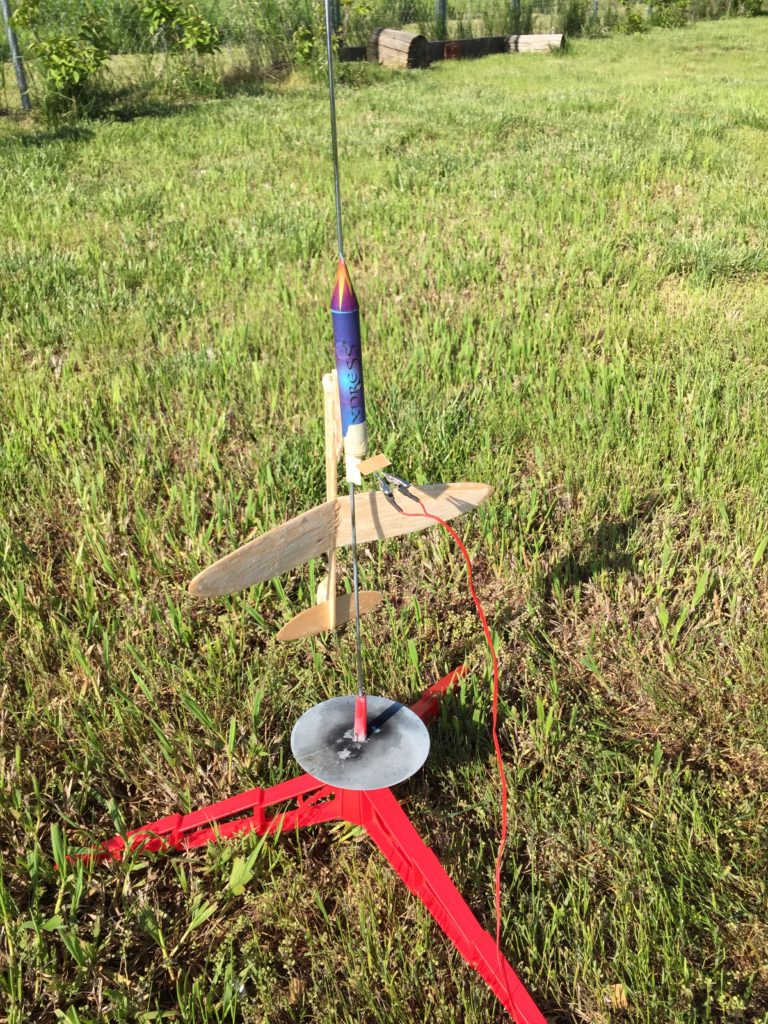
The launch conditions were near perfect, with clear skies and almost no wind. The rocket boosted off the pad and appeared to encounter a stronger wind a few hundred feet into the flight causing it to lay over slightly. When the ejection charge fired, the pop pod sepparated from the glider, and descended under a streamer. The shock cord was severed during the decent, but both pieces were recovered with in a few yards of each other.
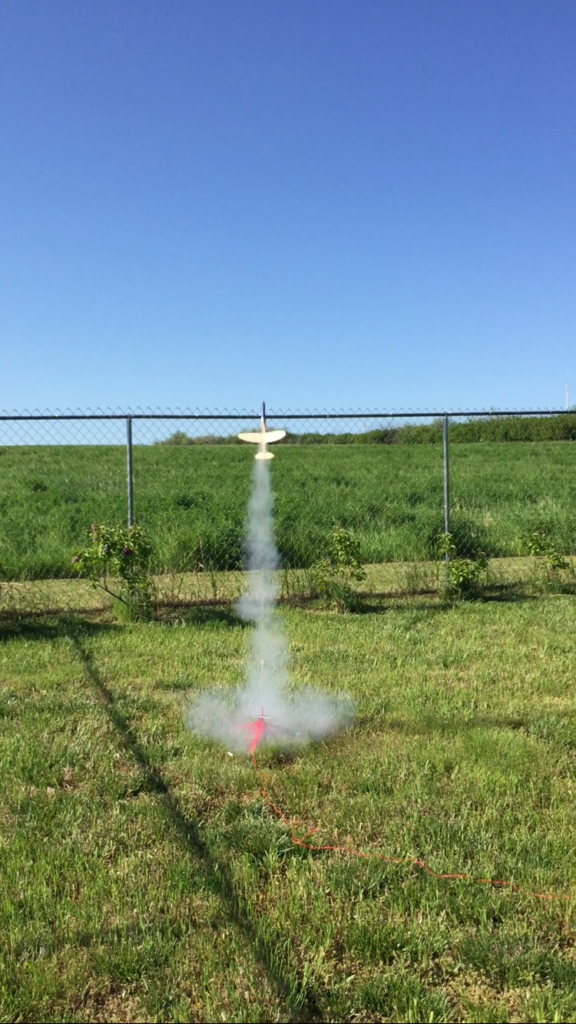
The glider succesfully transition to glide mode, and began a shallow, circular, glide path to the ground. The glider touched down 40 seconds after lifting off, successfully completing this portion of the Nartrek Silver Achievement on May 28, 2017.
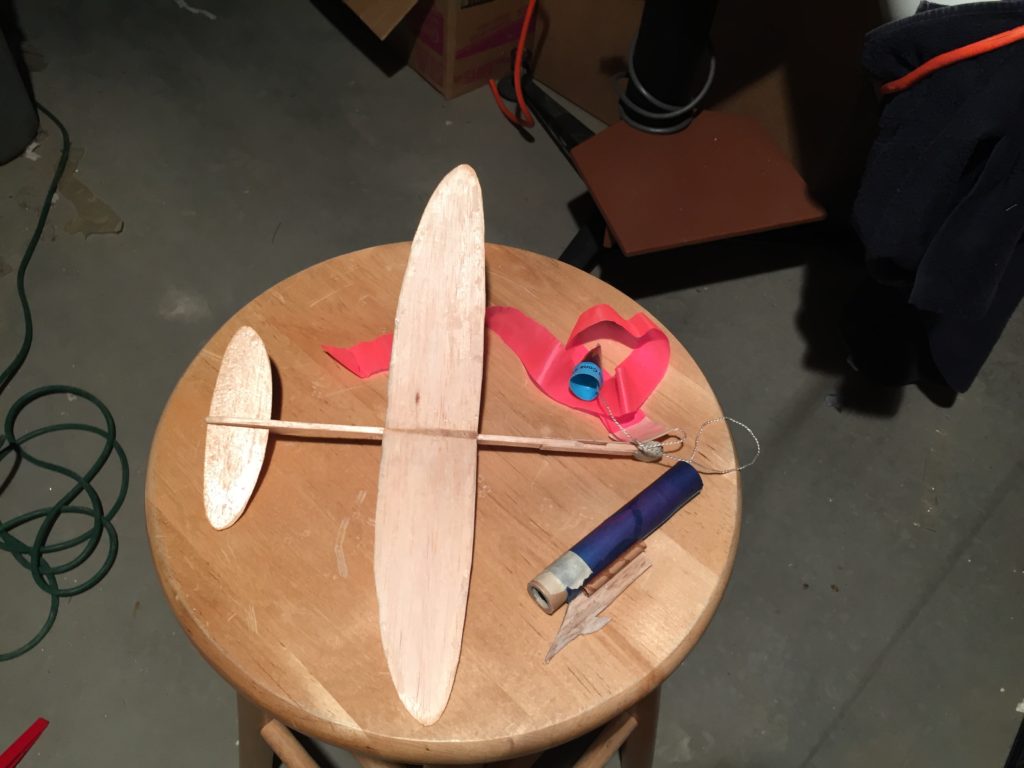
Build and successfully fly a scale model from an existing model rocket kit, or construct a scale model from basic parts using scale data obtained from the sources outlined in the accompanying documents. With a second party, make an honest evaluation of your model using the form provided.
The Estes Nike Smoke Alpha rocket was chosen for this section. The rocket was completed per the Estes instructions, and special care was taken to ensure the fins were correctly profiled. The rocket was painted and detailed based on the Estes instructions and various on-line sources detailing the Nike Smoke color scheme. The Estes C6-5 motor was used, along with the standard Estes parachute.
Objective Judging of Scale Model
Once the rocket was completed and detailed, it was then judged by Andrea using the NARTREK supplied score sheet. The results were as follows:
- Scale Data: 47 out of 50
- Adherence to Scale:
- Accuracy of Major Dimensions: 190 out of 200
- Color and Markings: 100 out of 100
- Accuracy of Details: 30 out of 50
- Degree of Difficulty: 80 out of 100
- Craftsmanship: 280 out of 300
- Flight Characteristics:
- Mission: 195 out of 200
- General Flight: 100 out of 100
The Total Score (Points Awarded) was 1022 out of 1100.
In order to allow for an accurate judging in the area of dimensional scale, the following scale drawing of an actual Nike Smoke rocket, created by H. Stein, was used along with the actual measurements of the model rocket. Estes advertises this rocket to be 1/10th scale, and the majority of the measurements were correct. A few smaller measurements appeared to be off, but this was more likely caused by inadequate measuring tools than actually being out of scale.
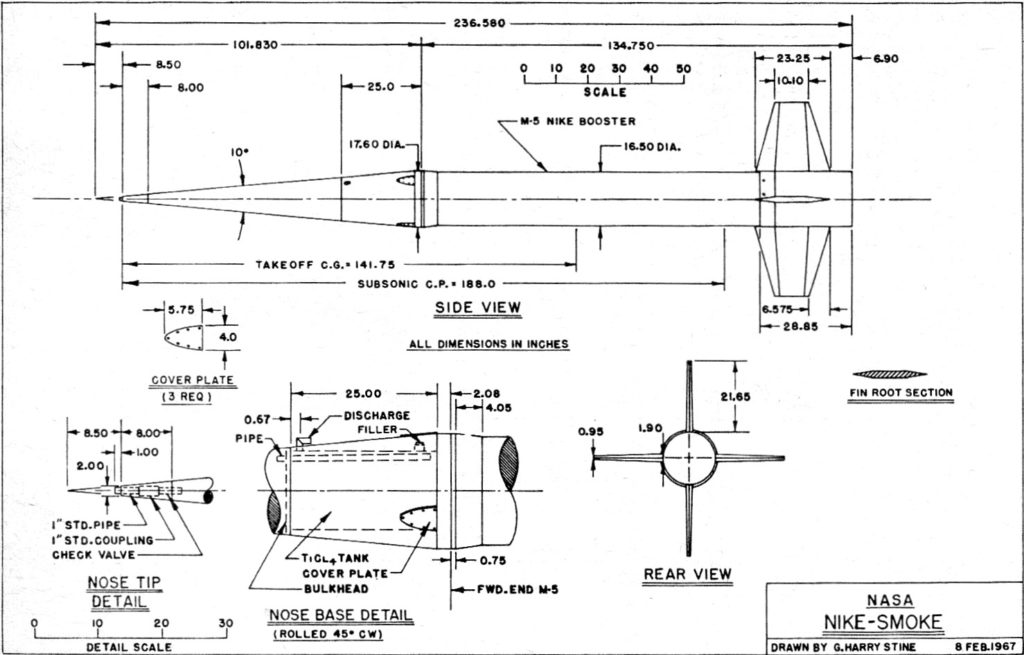
LAUNCH
The rocket’s objective judging was completed on May 21, 2017, and despite the seemingly ever present winds (6-10 mph winds) the weather was beautiful for a launch attempt.
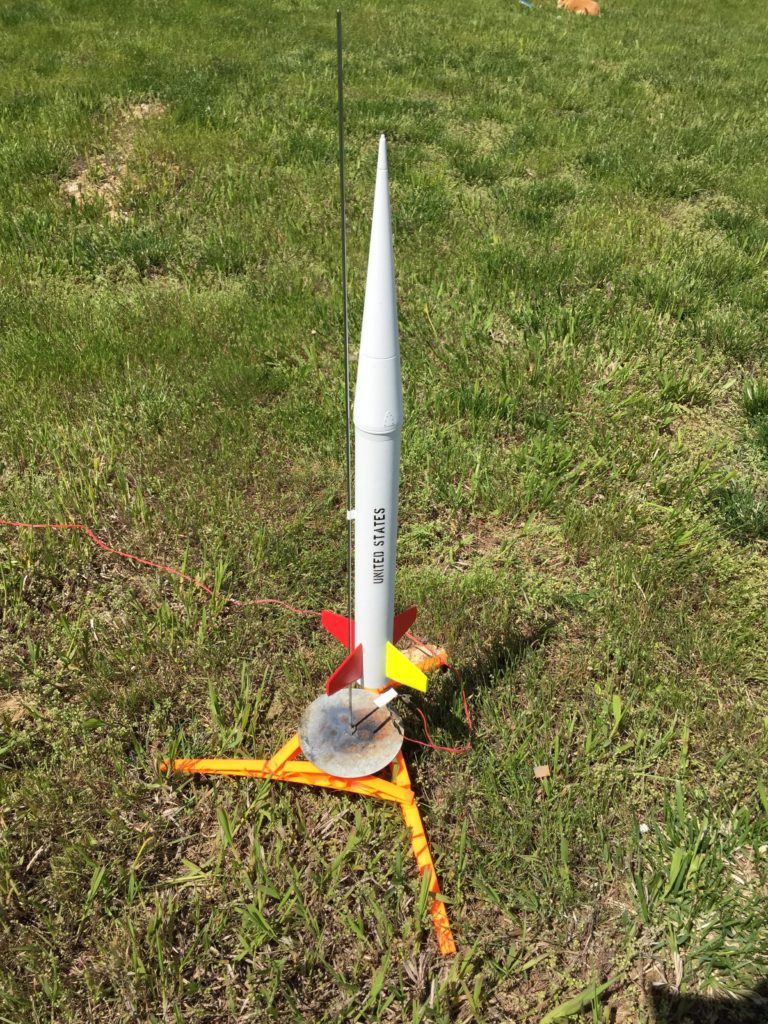
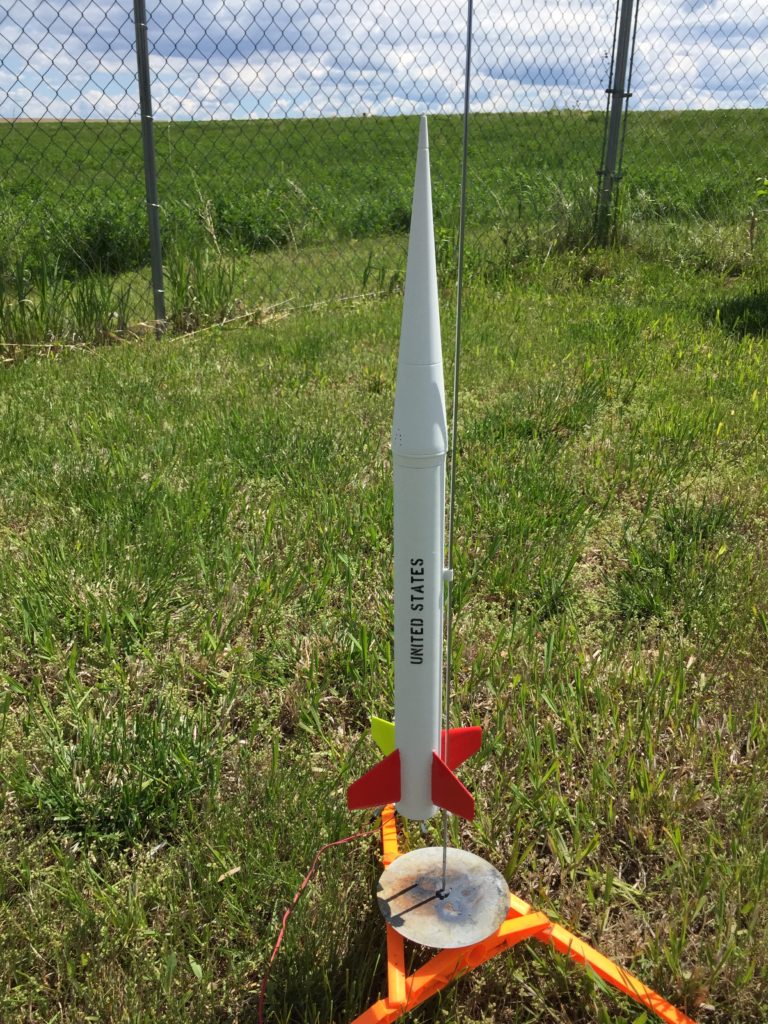
I was assisted with the launch, and the launch and flight characteristics were witnessed by Iain and Andrea.
The launch was without incident, and the rocket boosted quickly off the pad.
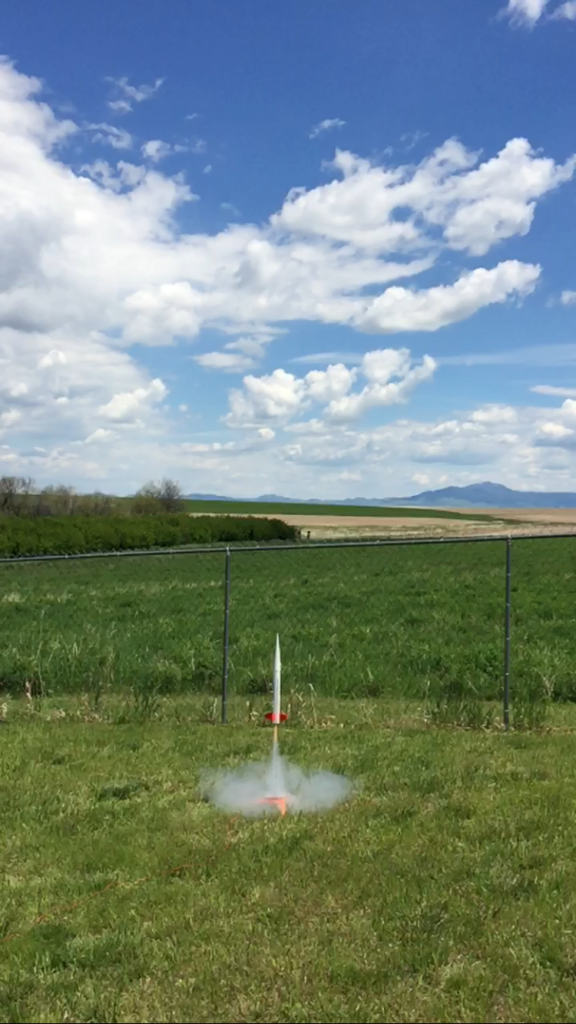
The rocket’s flight path was straight up with no weathercocking. The rocket was visually tracked to apogee, and the white “tracking smoke” from the motor simulated the smoke that the actual rocket would have emitted to allow for the winds at altitude to be measured.
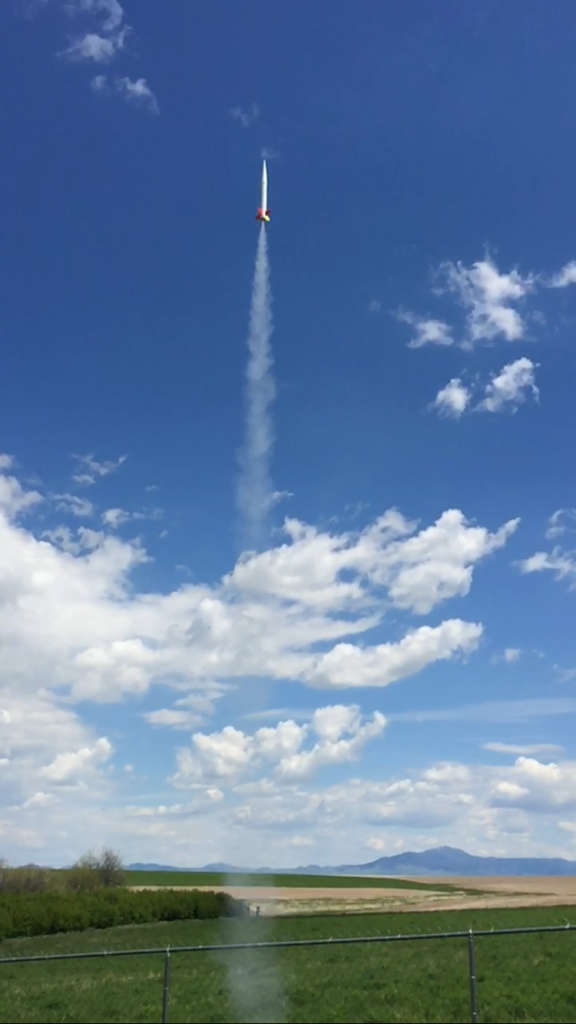
Shortly after laying over, the parachute was observed to deploy and the rocket began a slow descent.
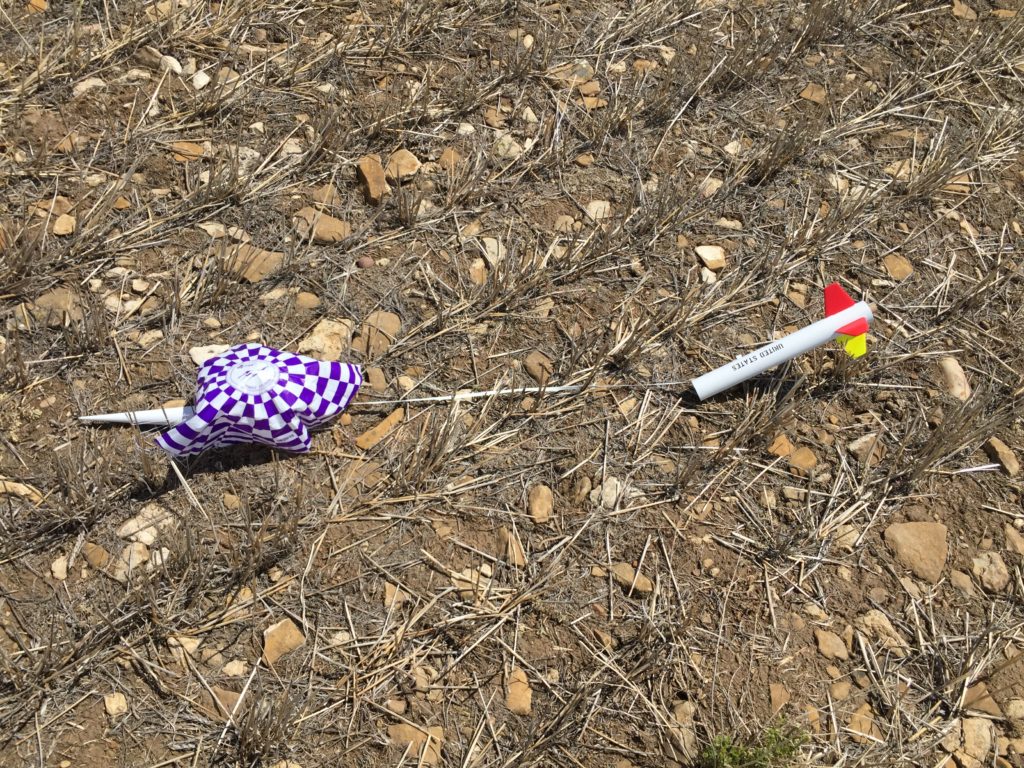
The rocket landed approximately 250 yards from the pad, and was recovered without any major damage. The top of the body tube had a slight bend where it appeared to have impacted the ground on landing, but this was easily bent back leaving the rocket cosmetically unchanged by the launch.
The final section of the scoring worksheet was then completed and the final score totaled as 1022 points out of a possible 1100.
The scale model of the Nike Smoke rocket was objectively judged, flown, and recovered without damage, successfully completing this section of the Nartrek Silver Achievement on May 21, 2017, 2017.
